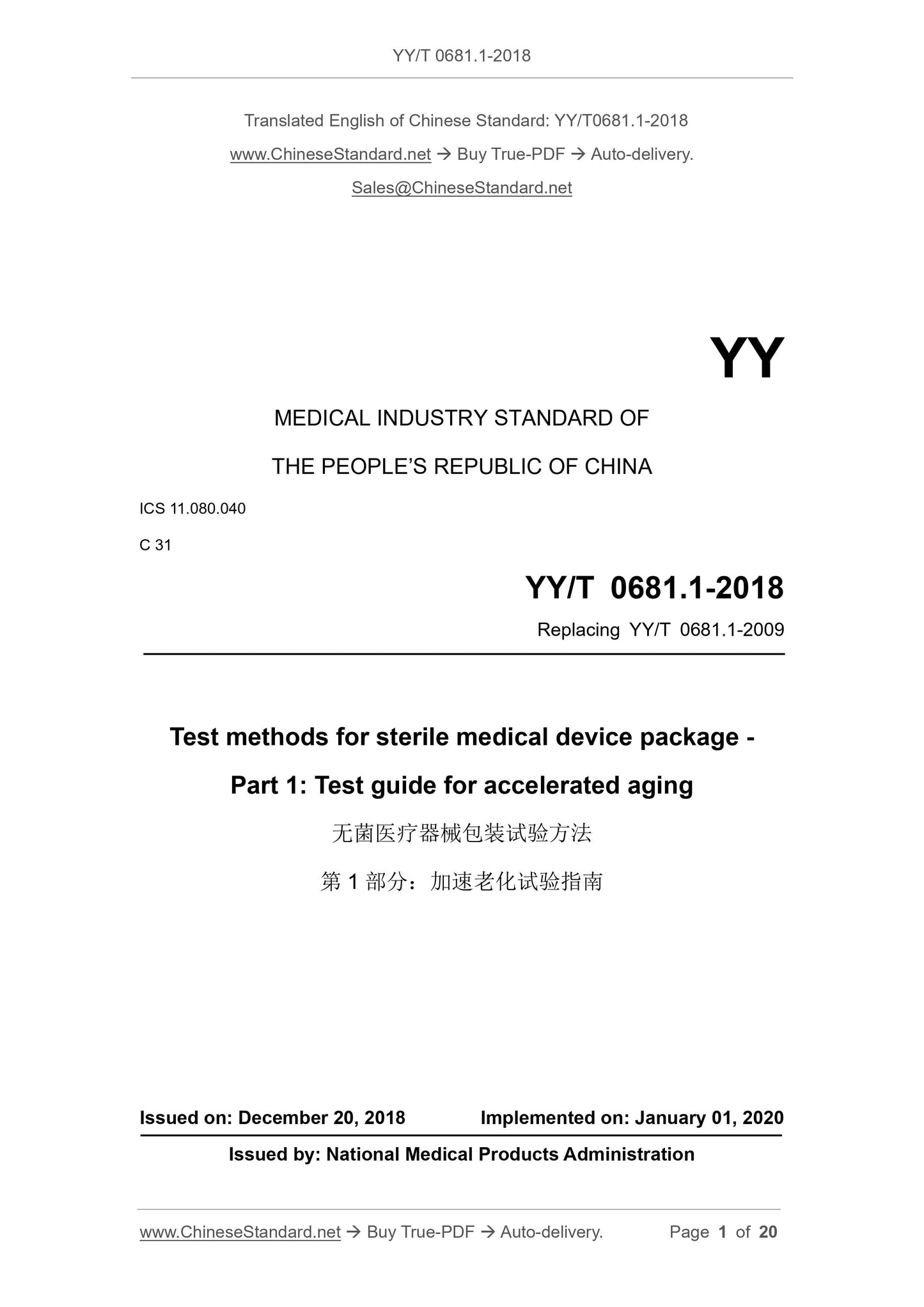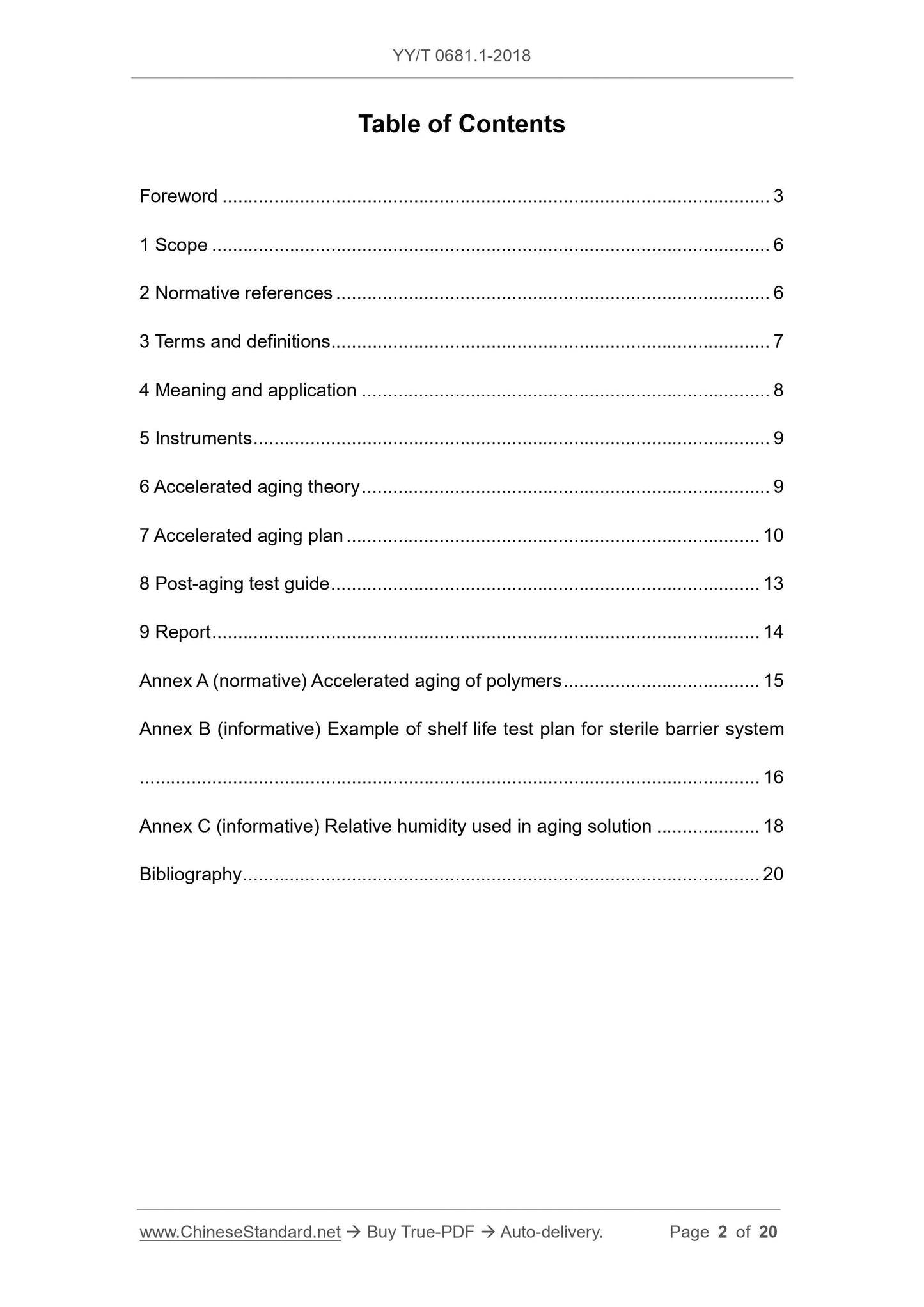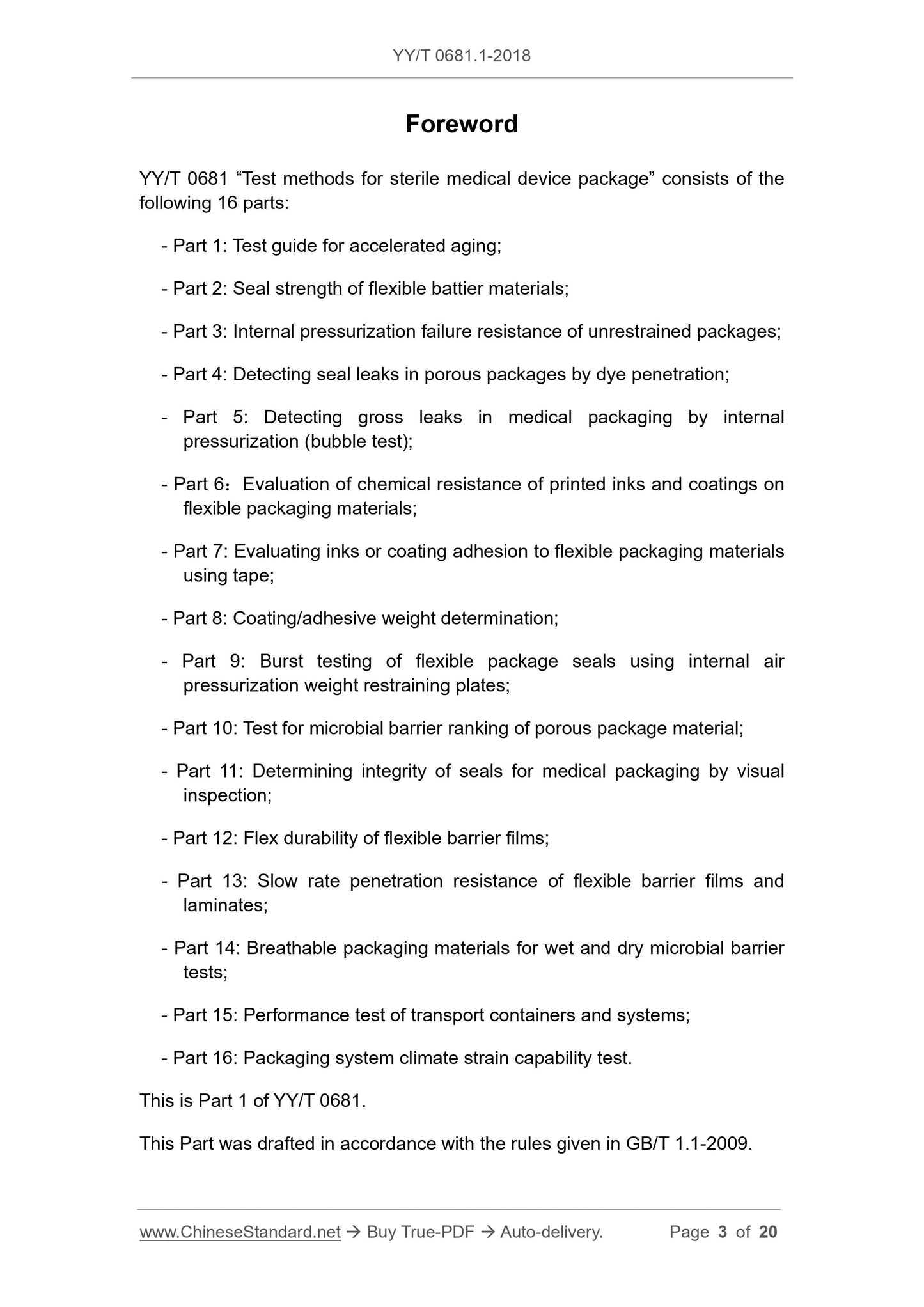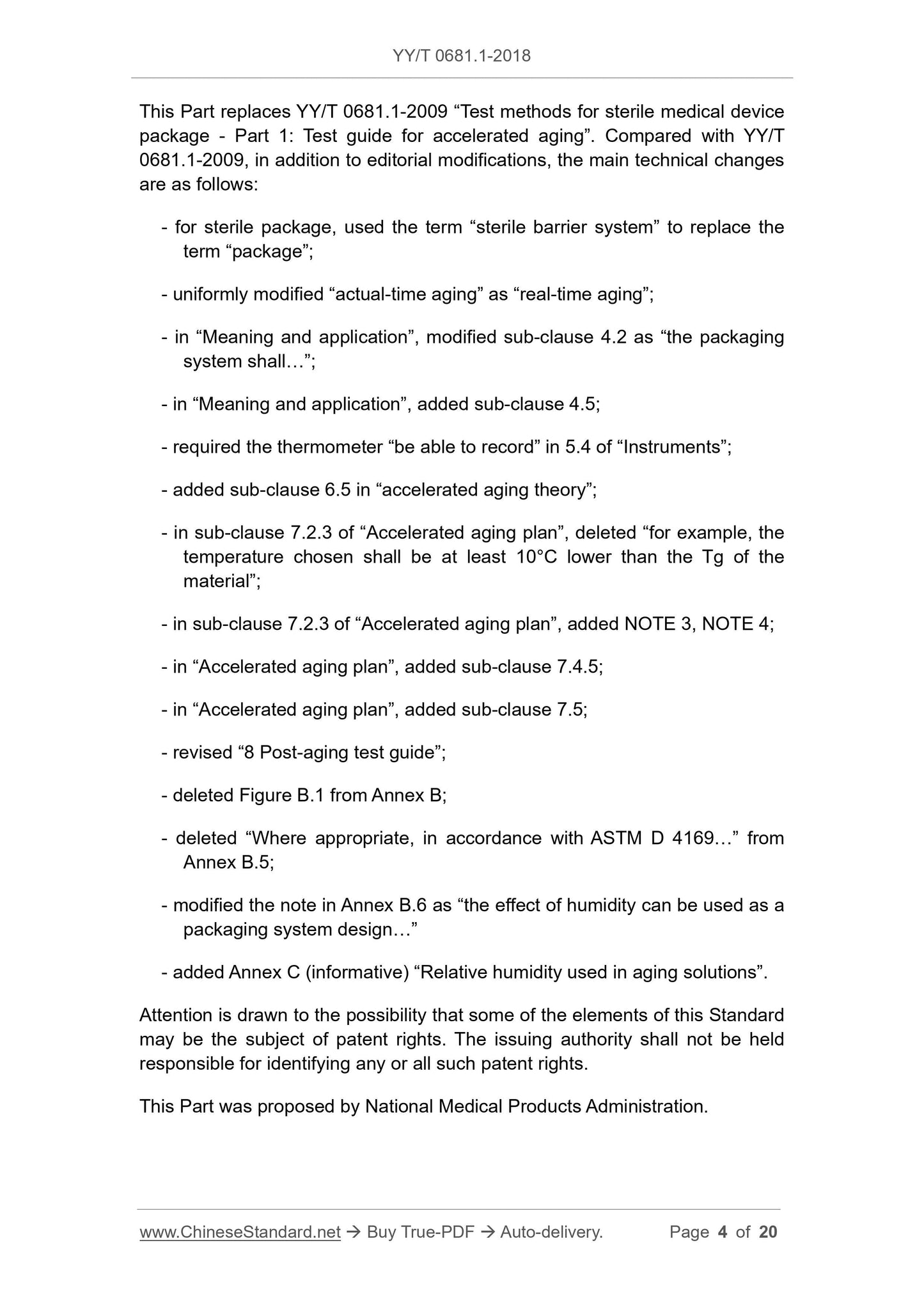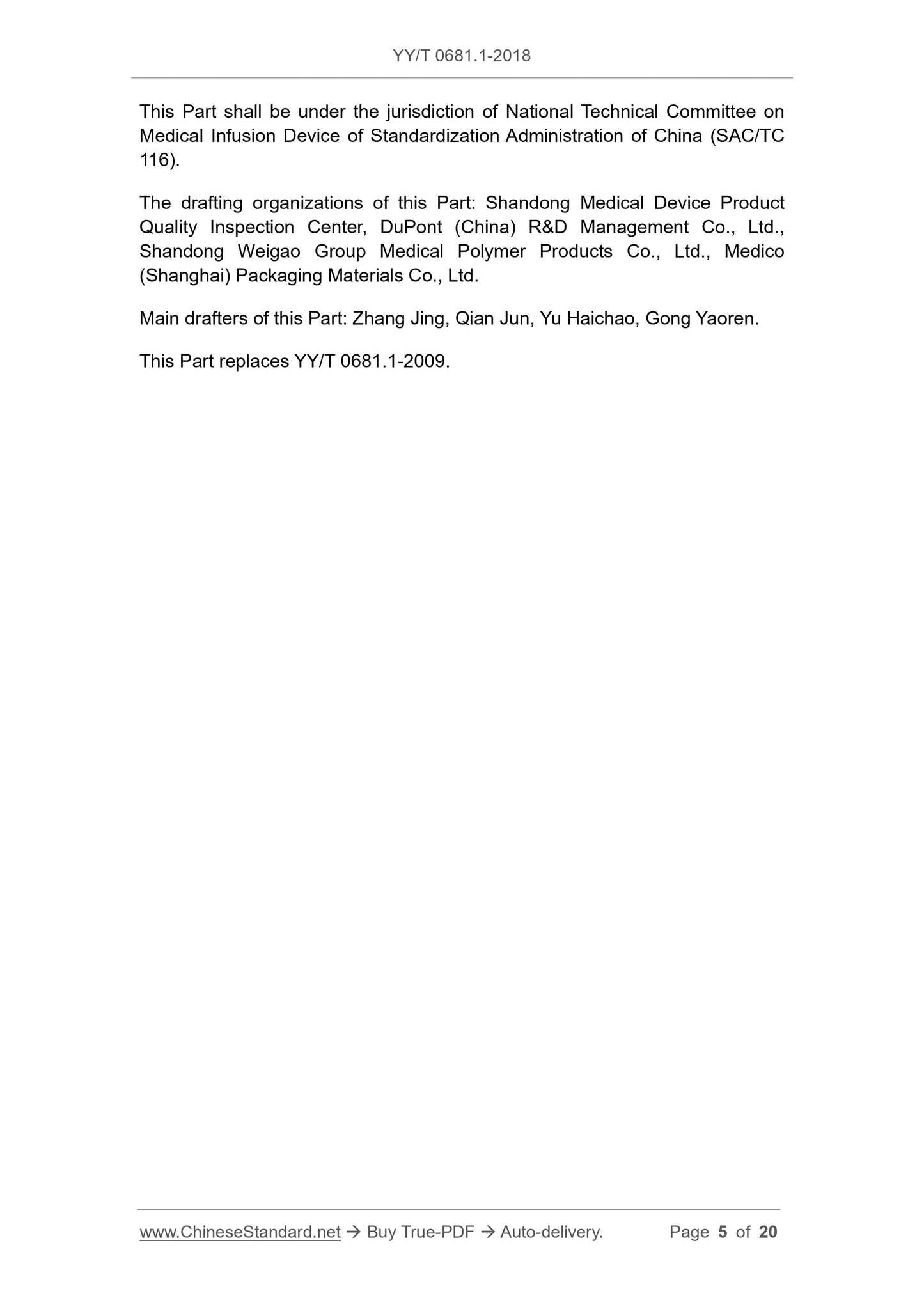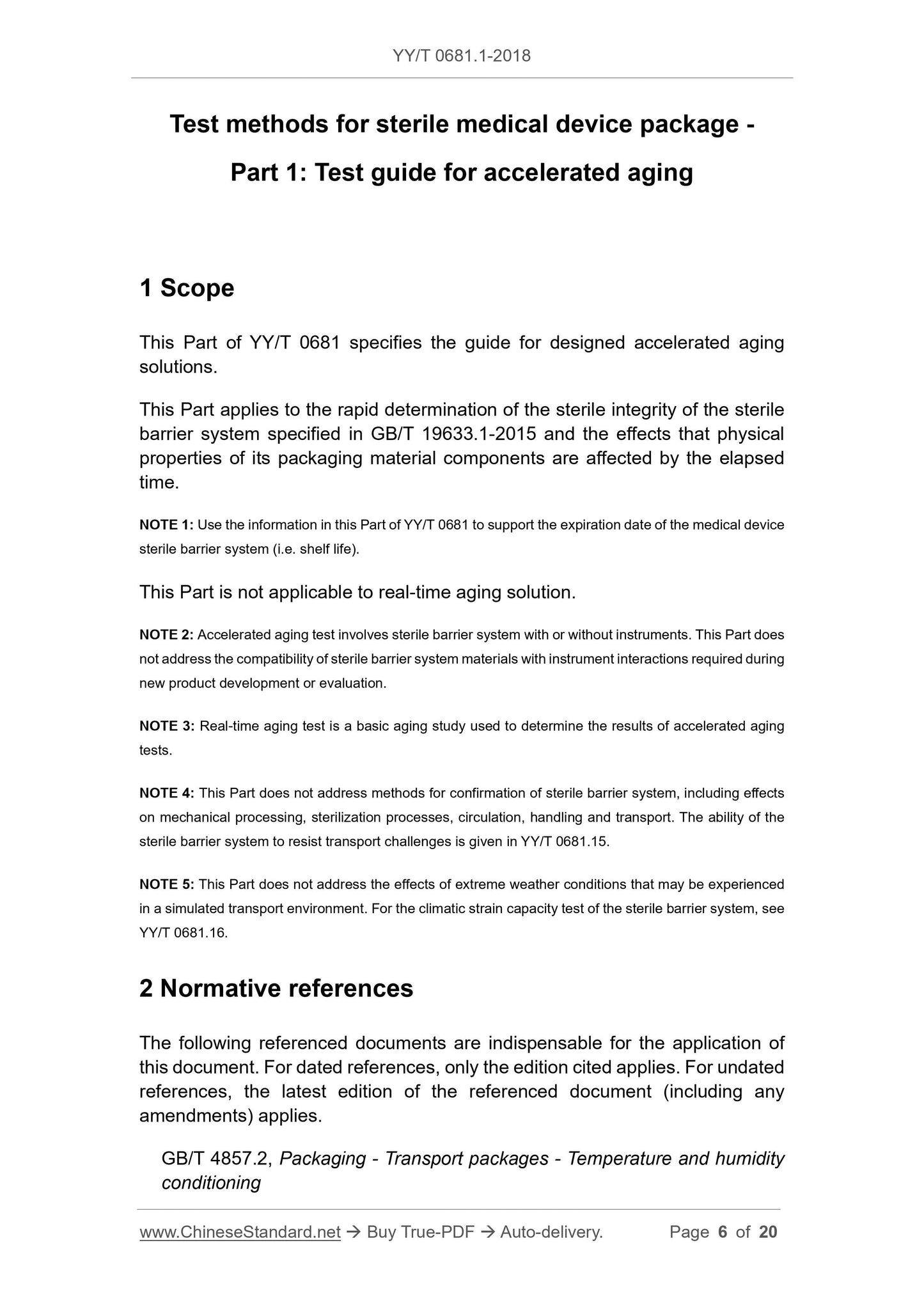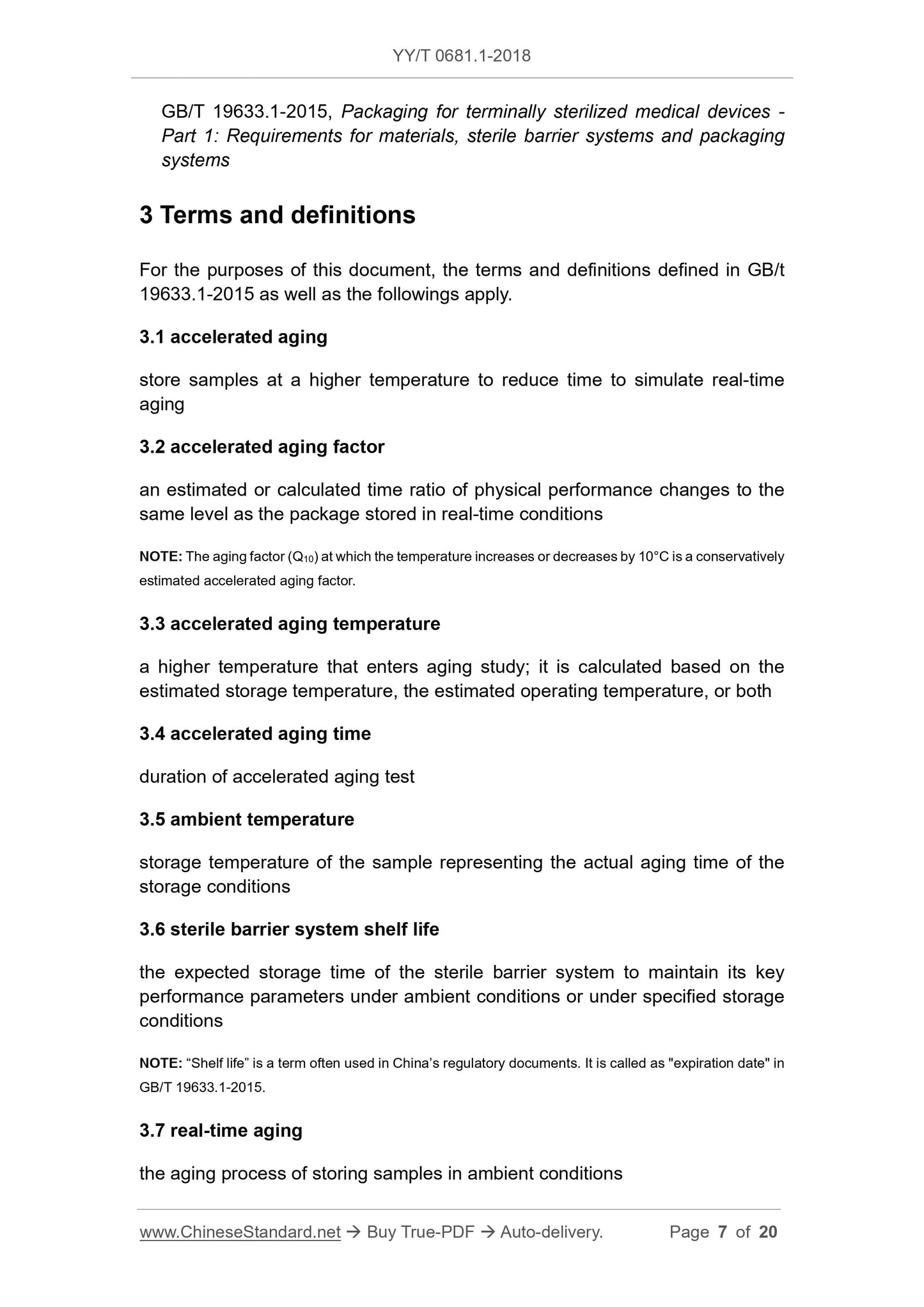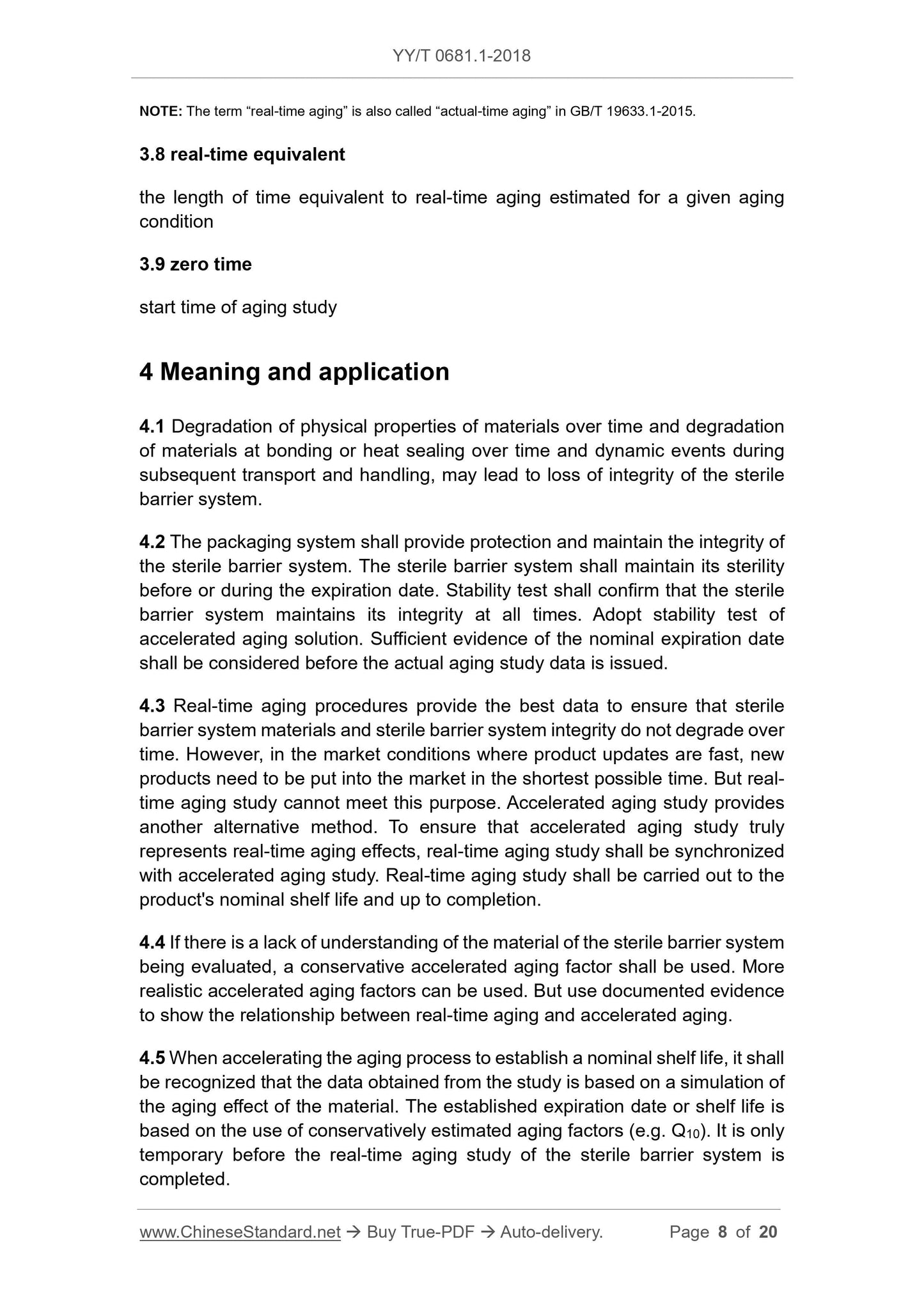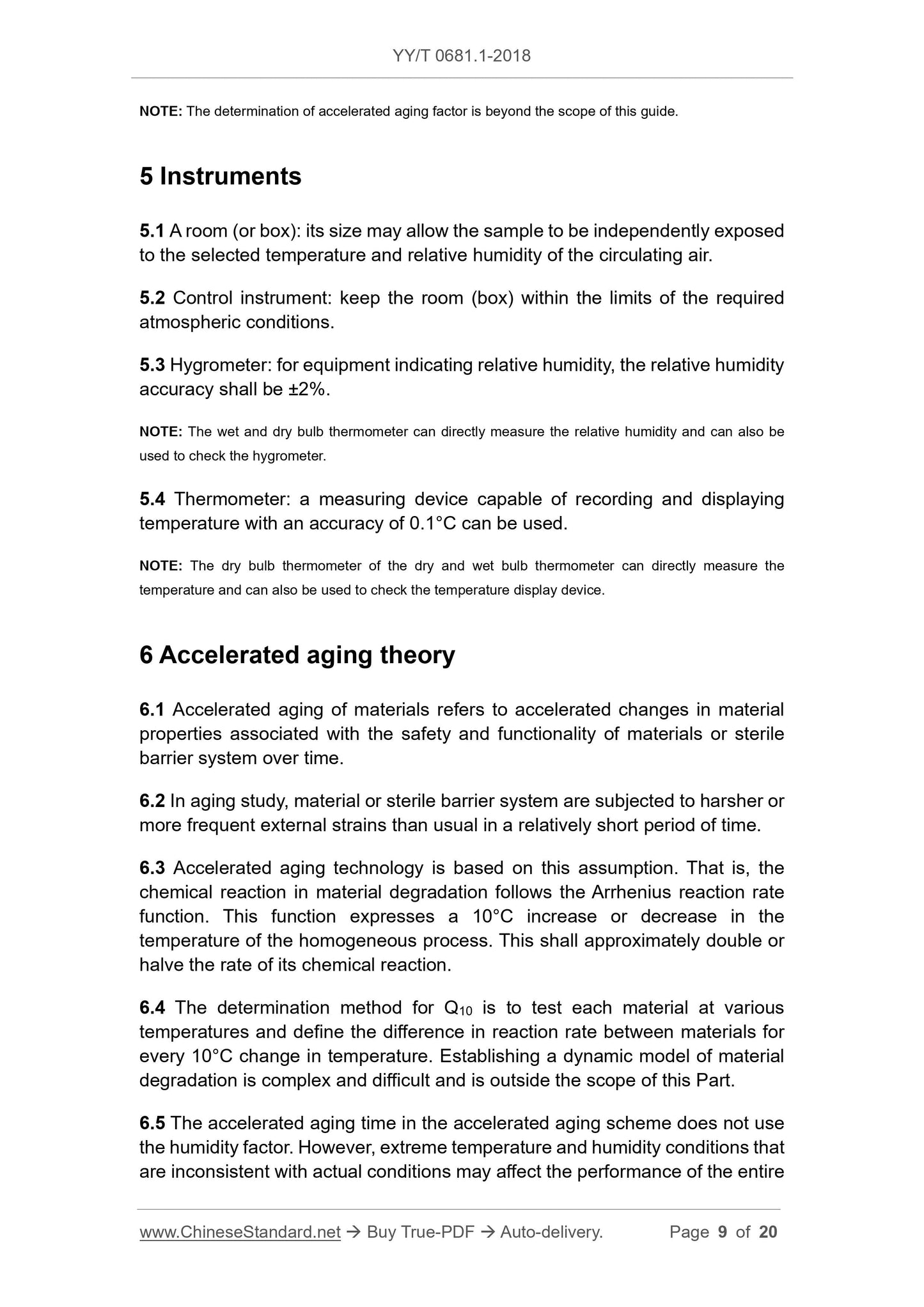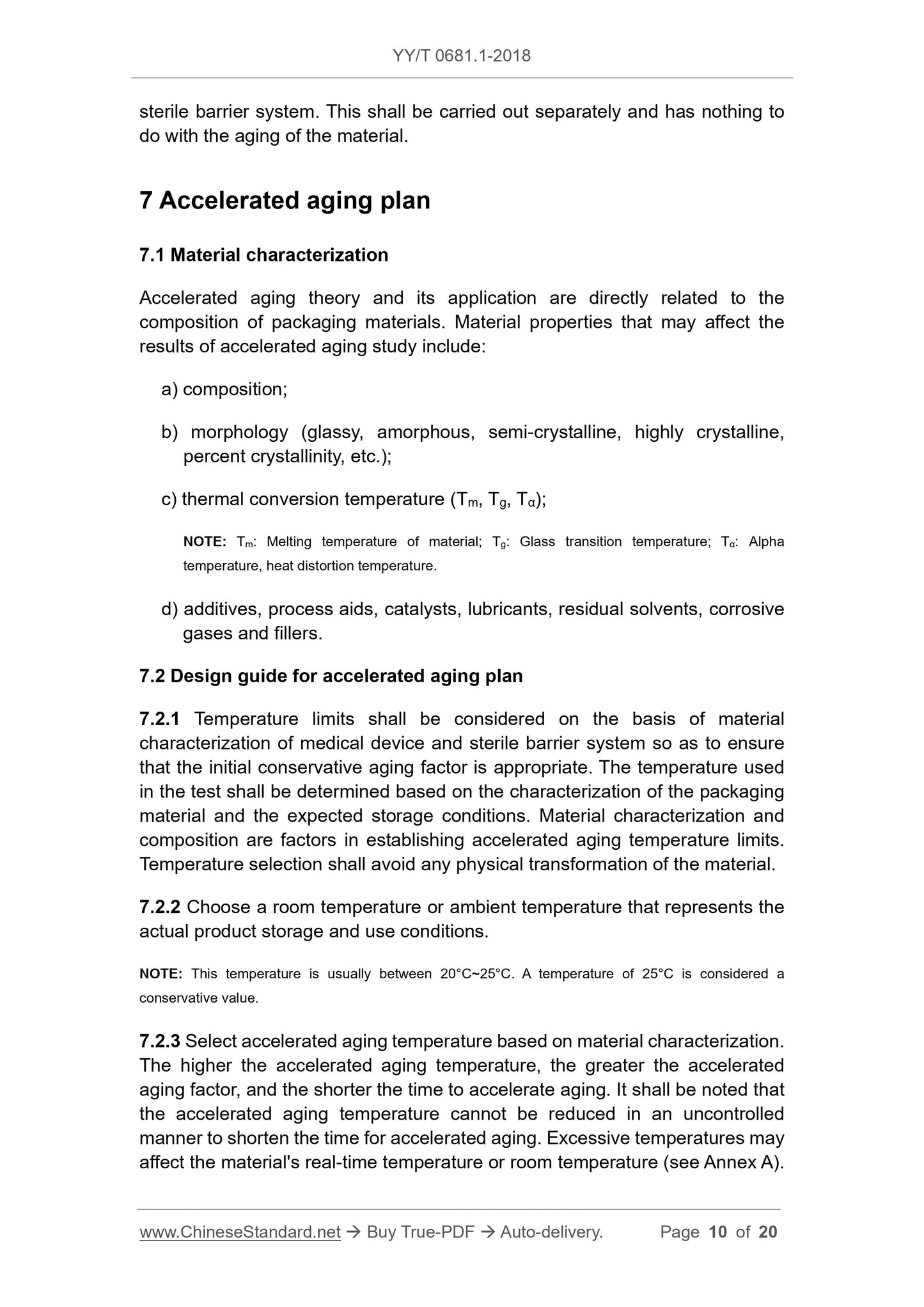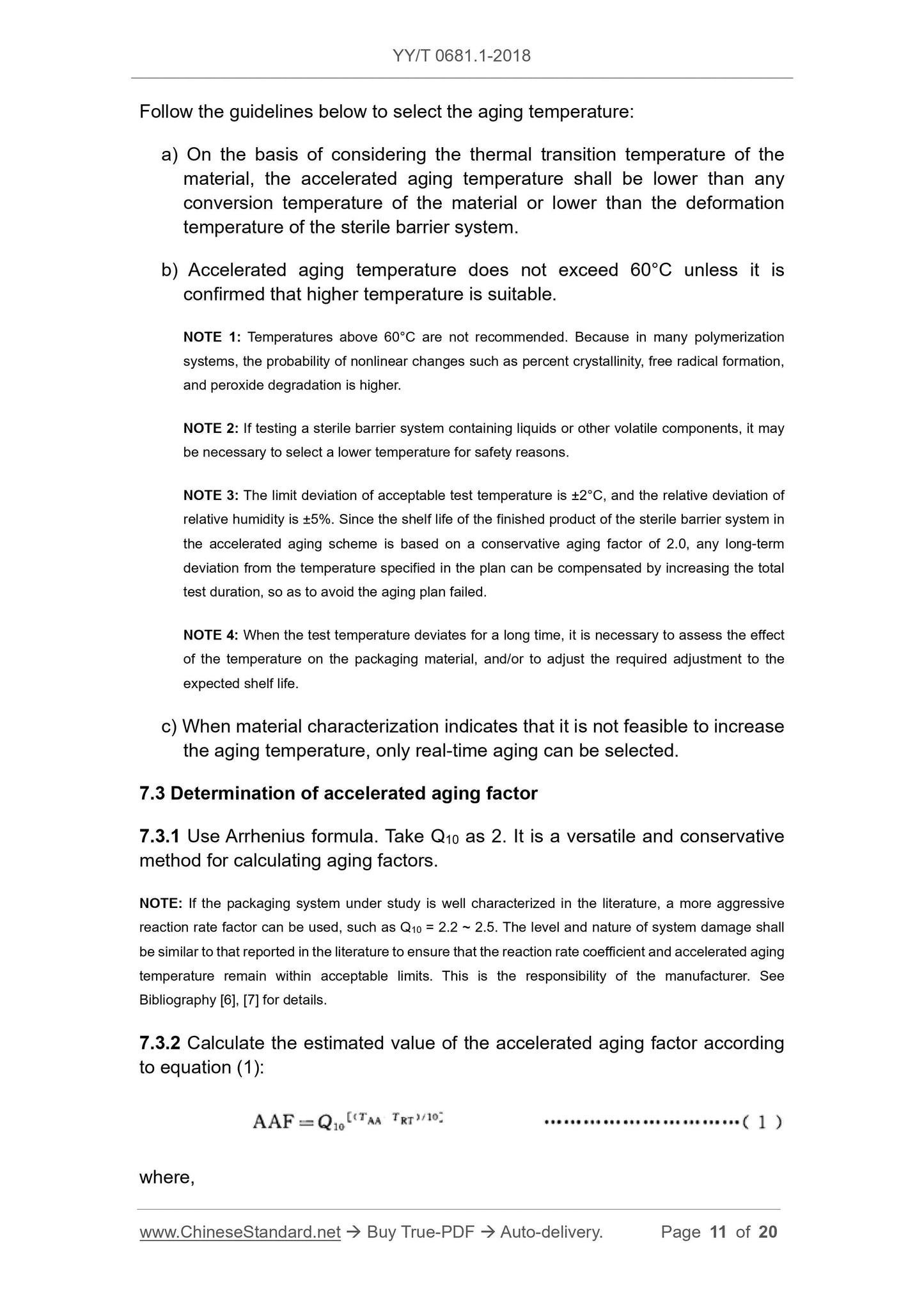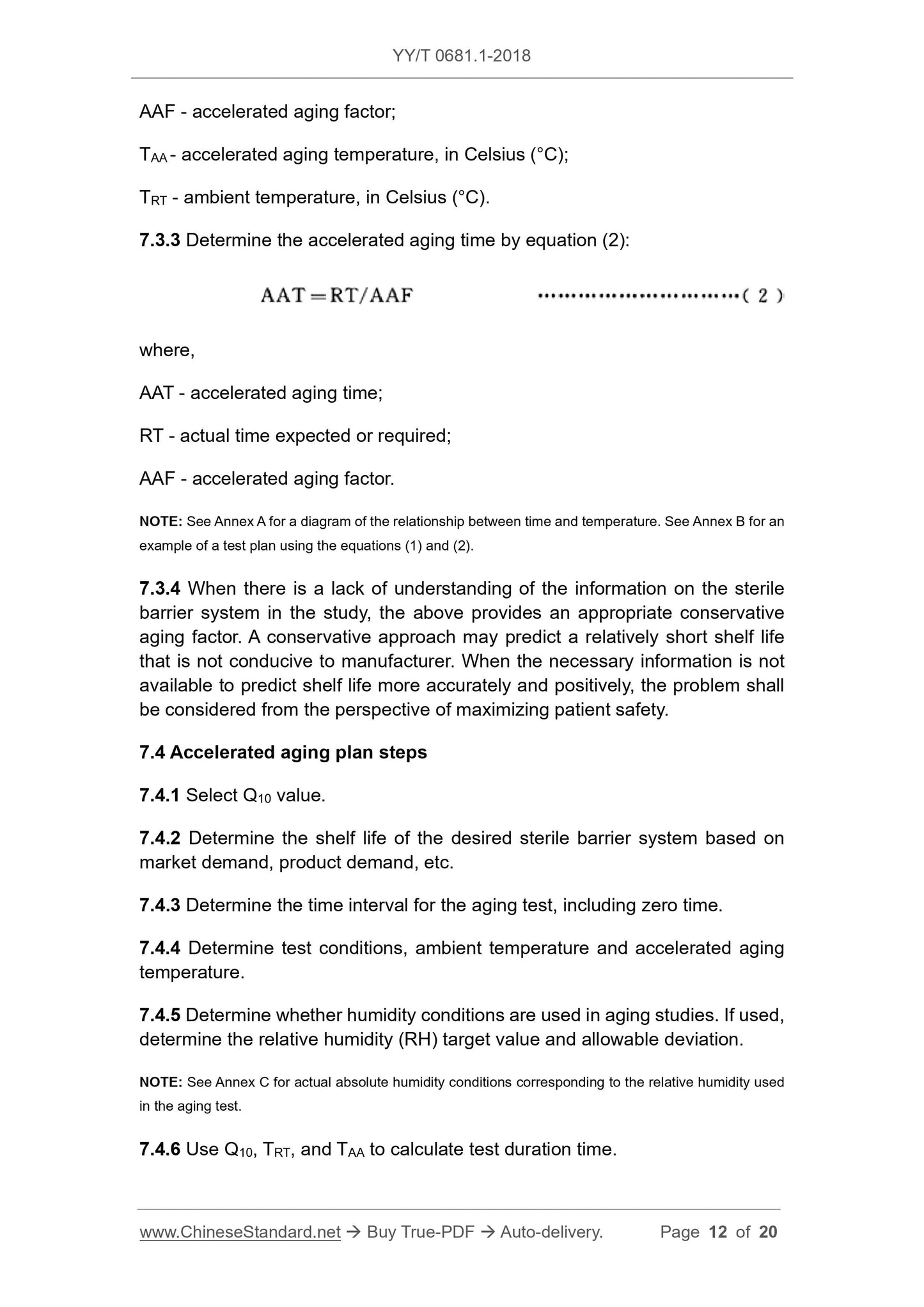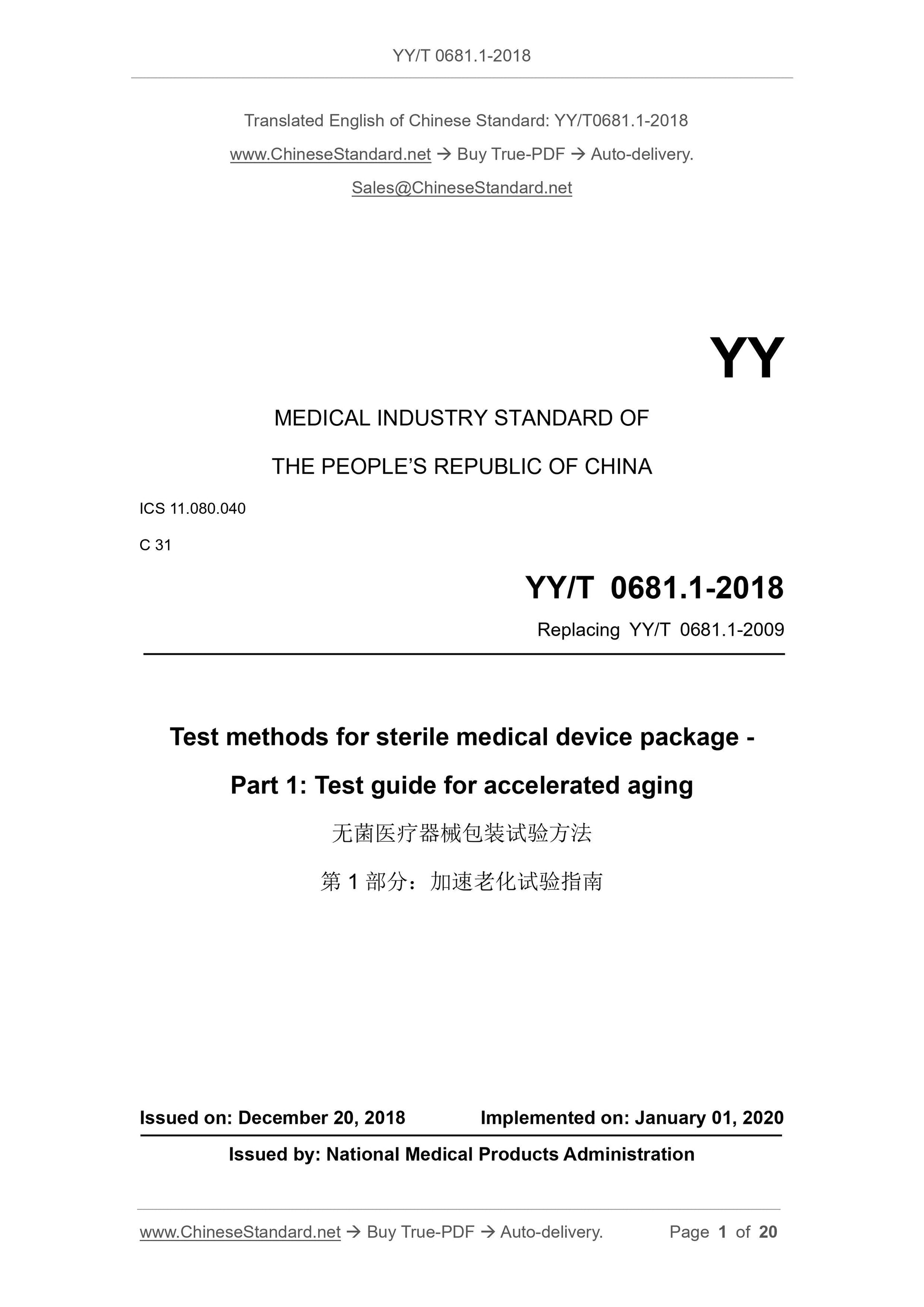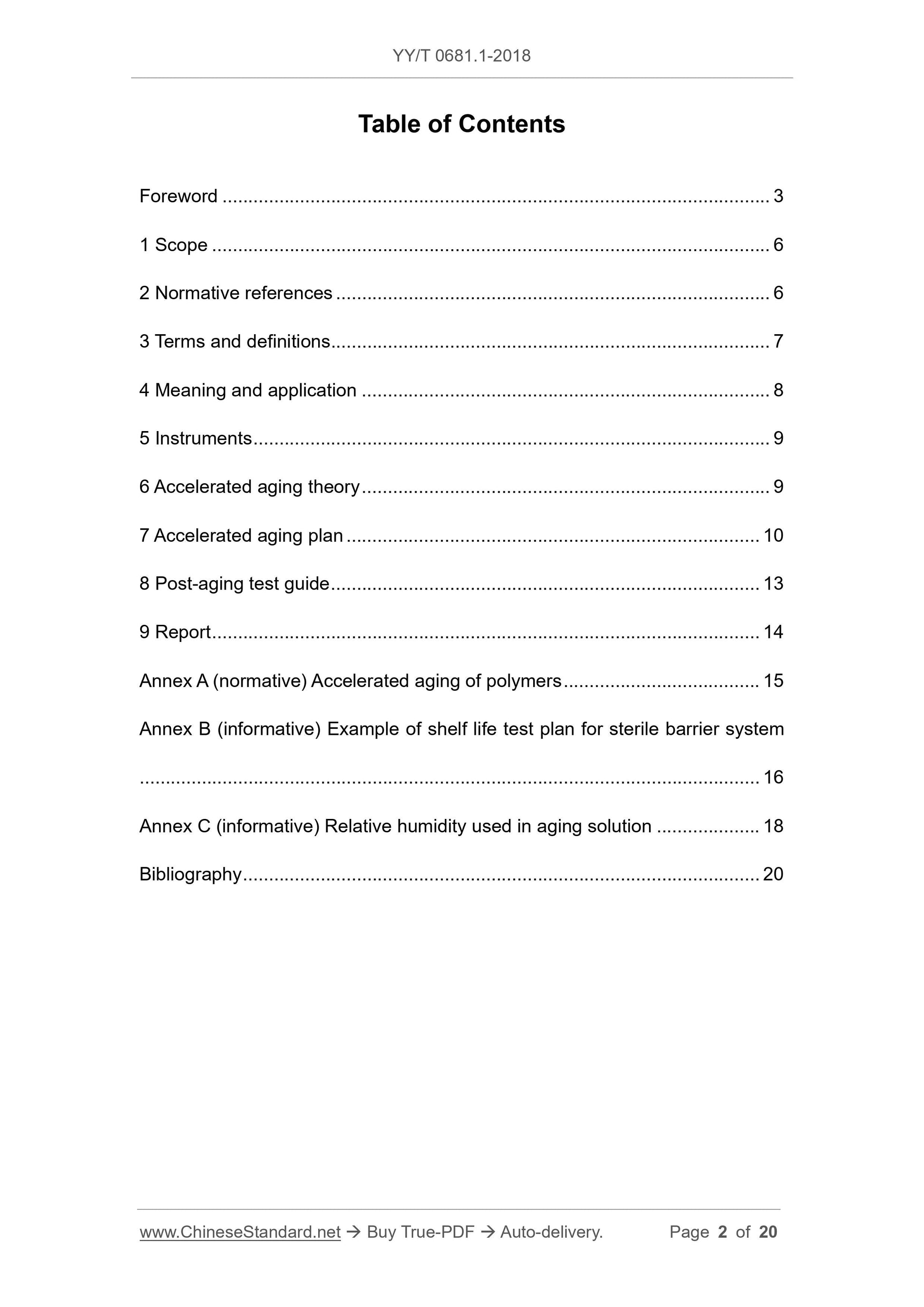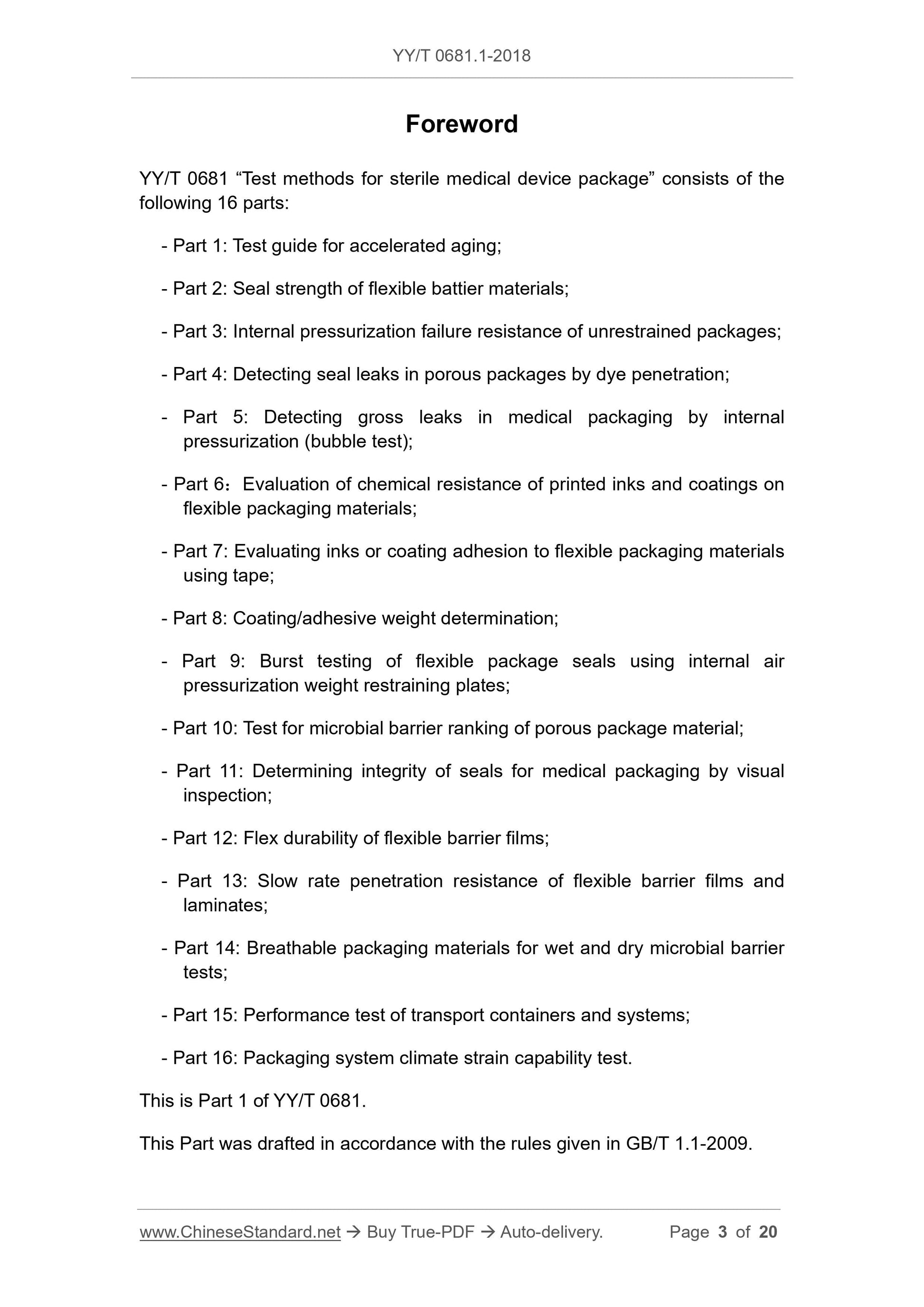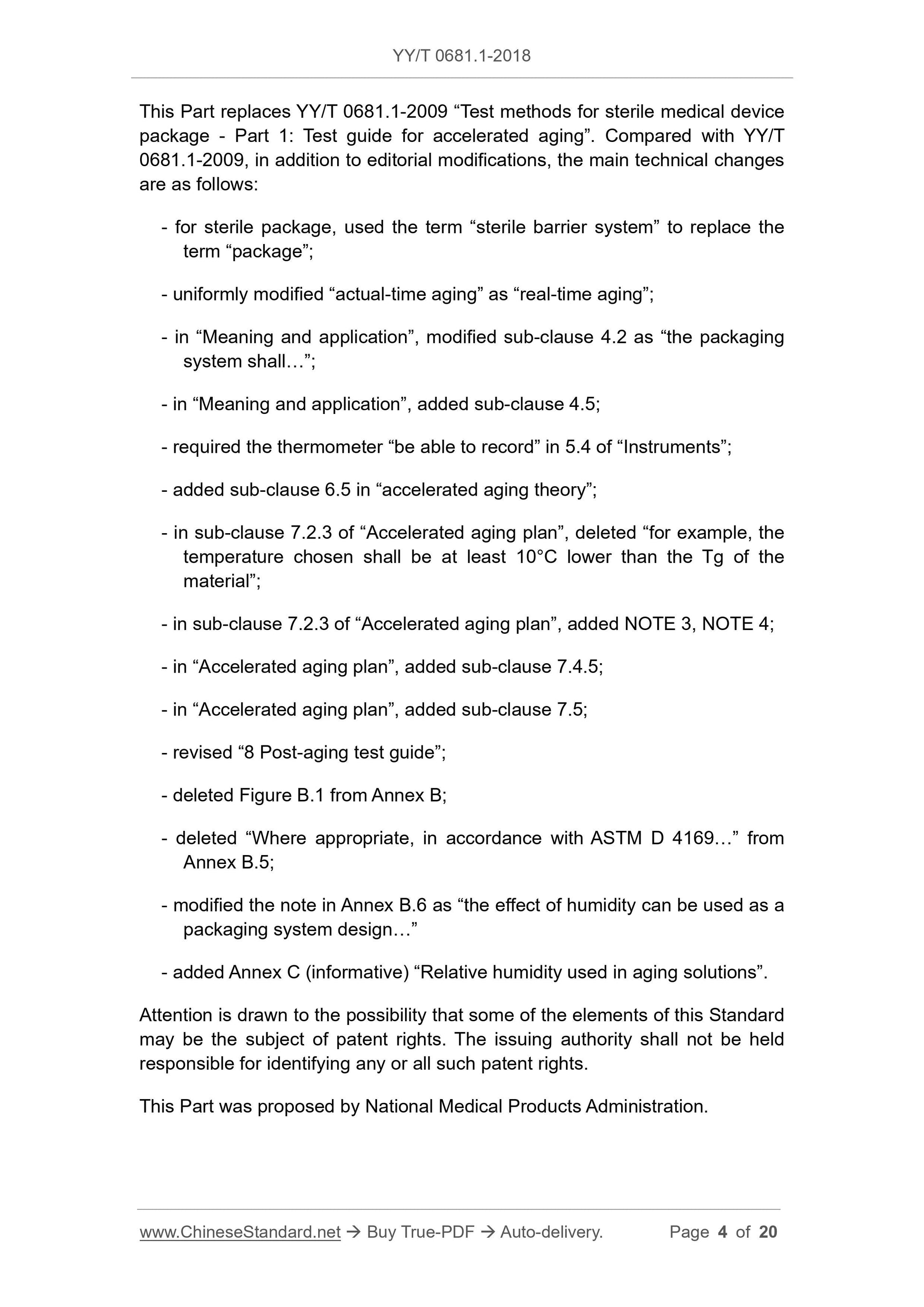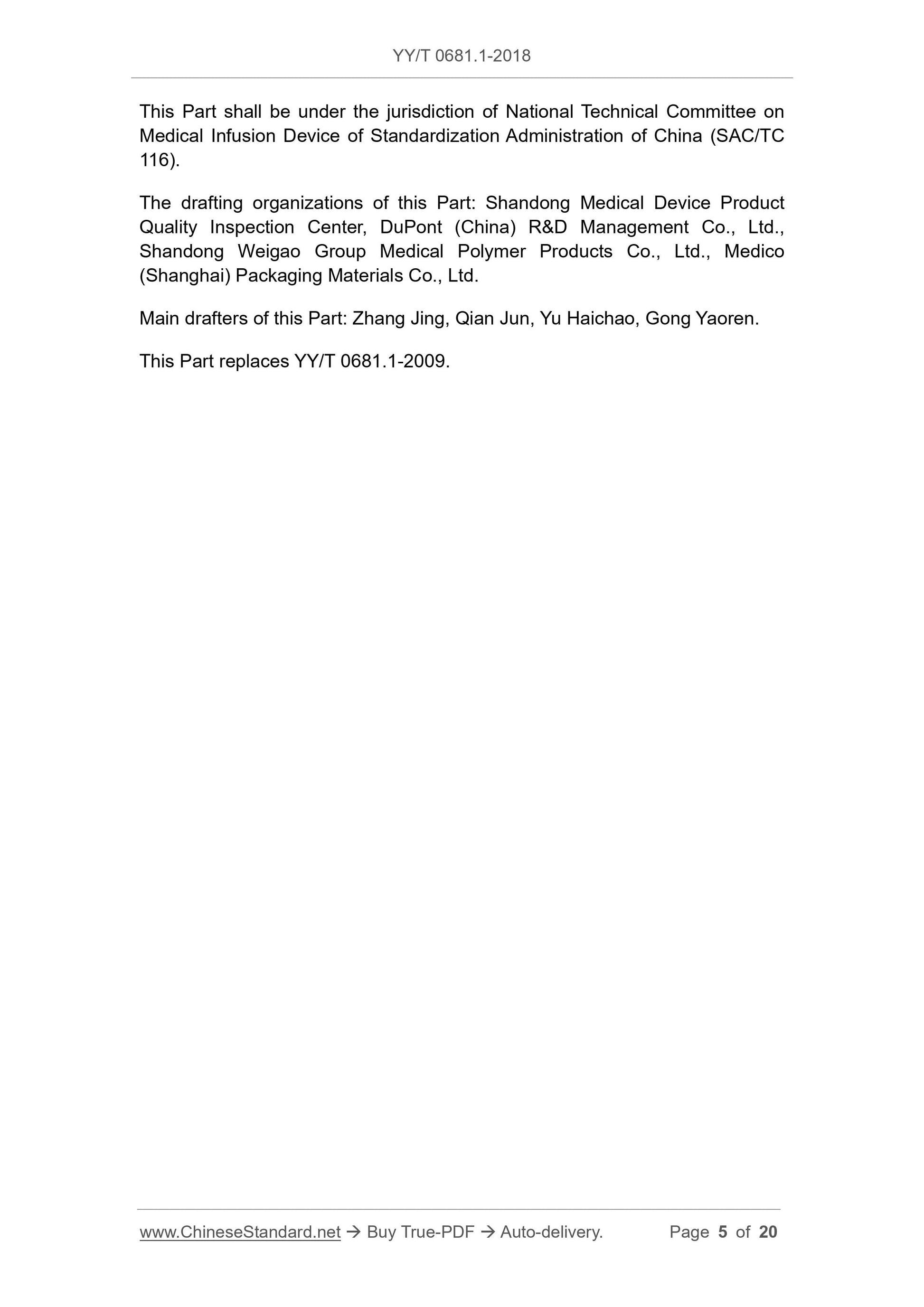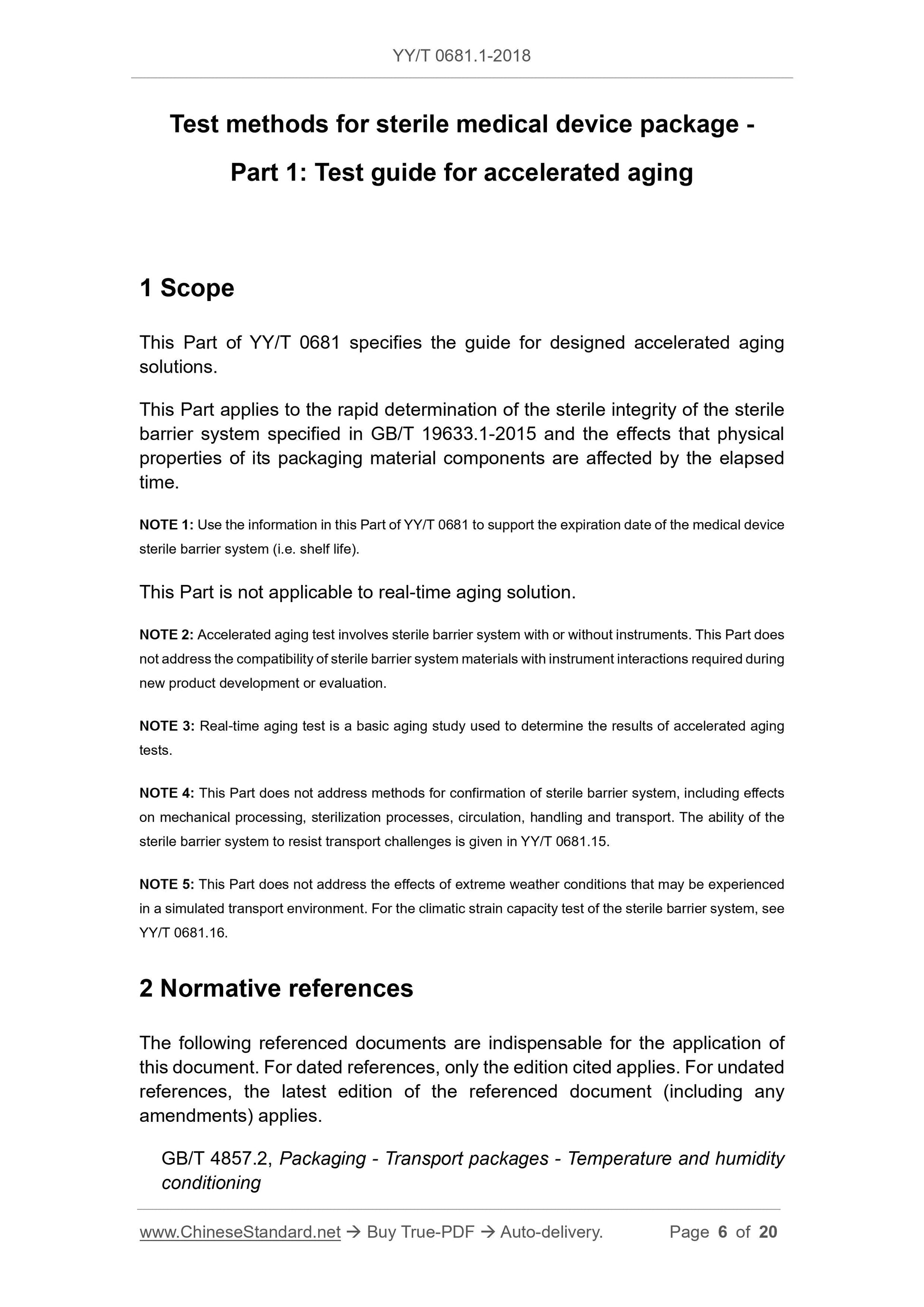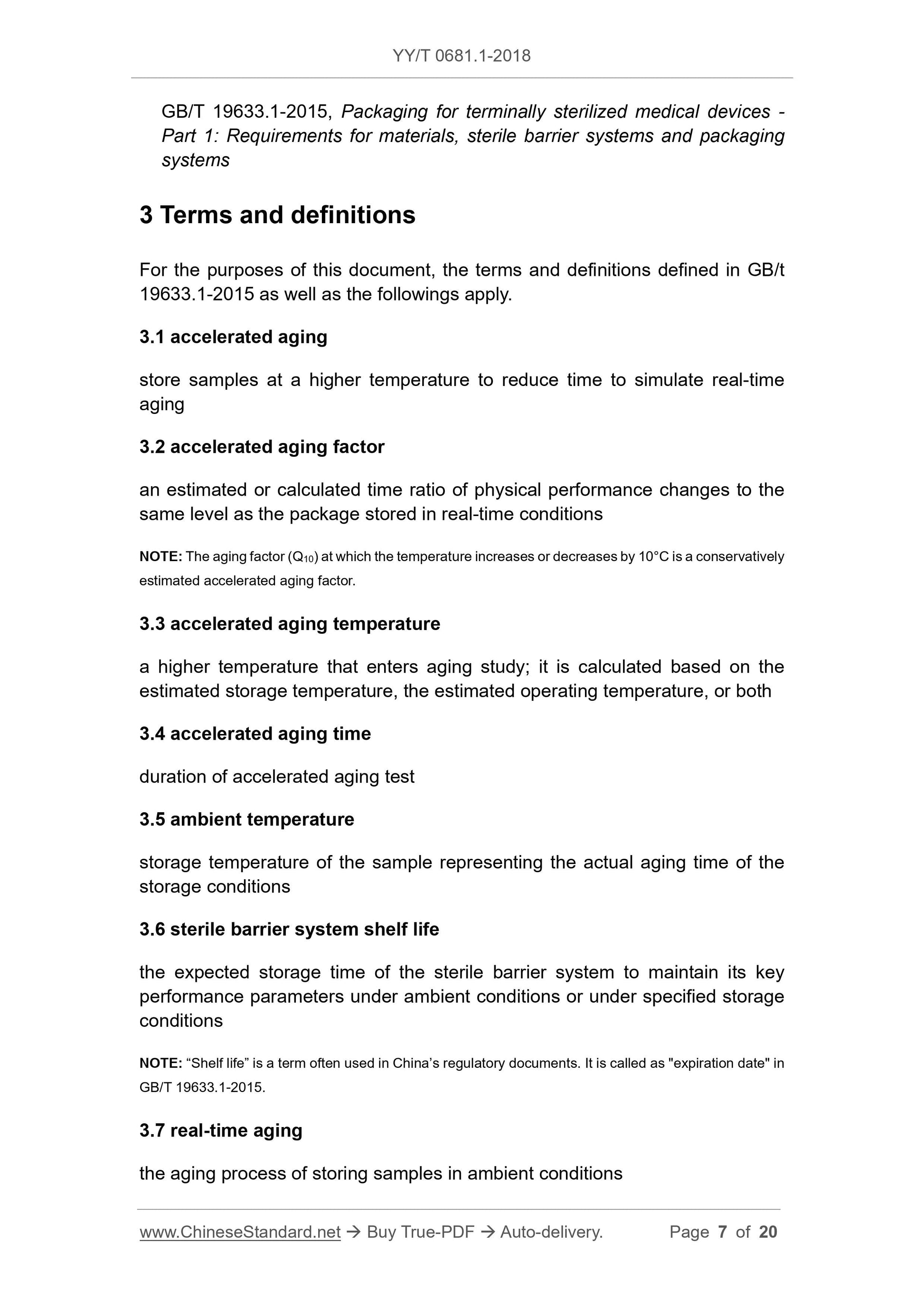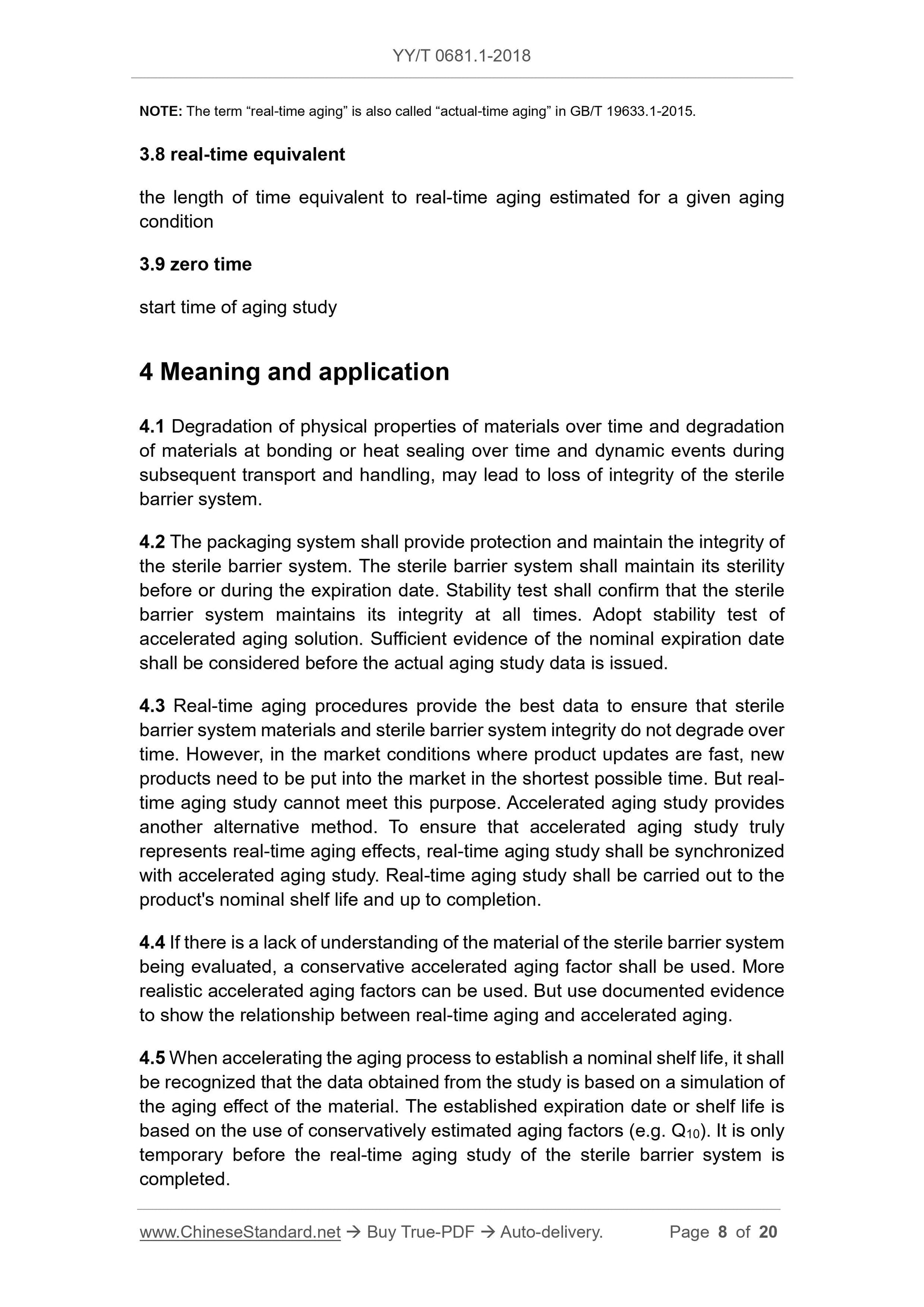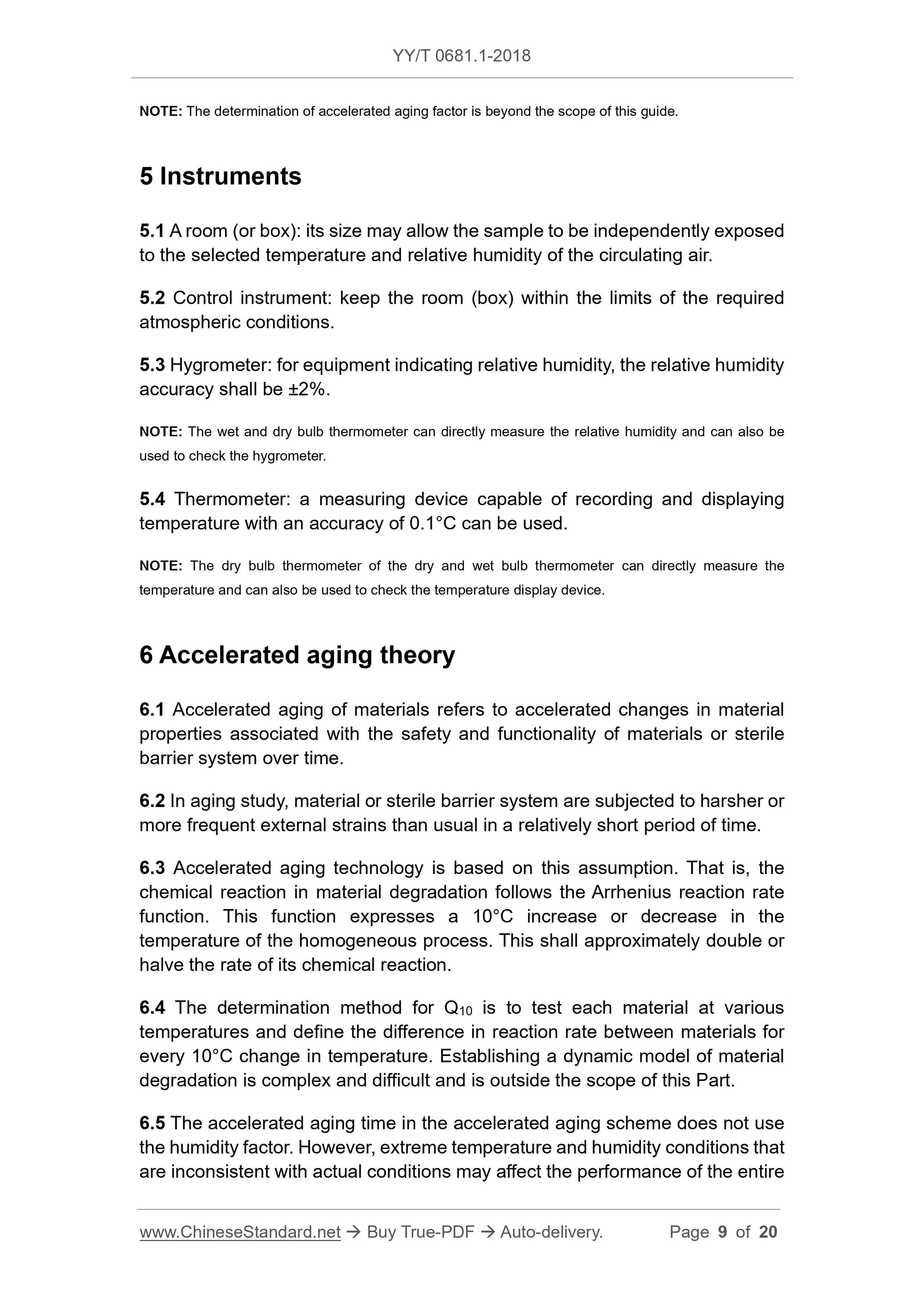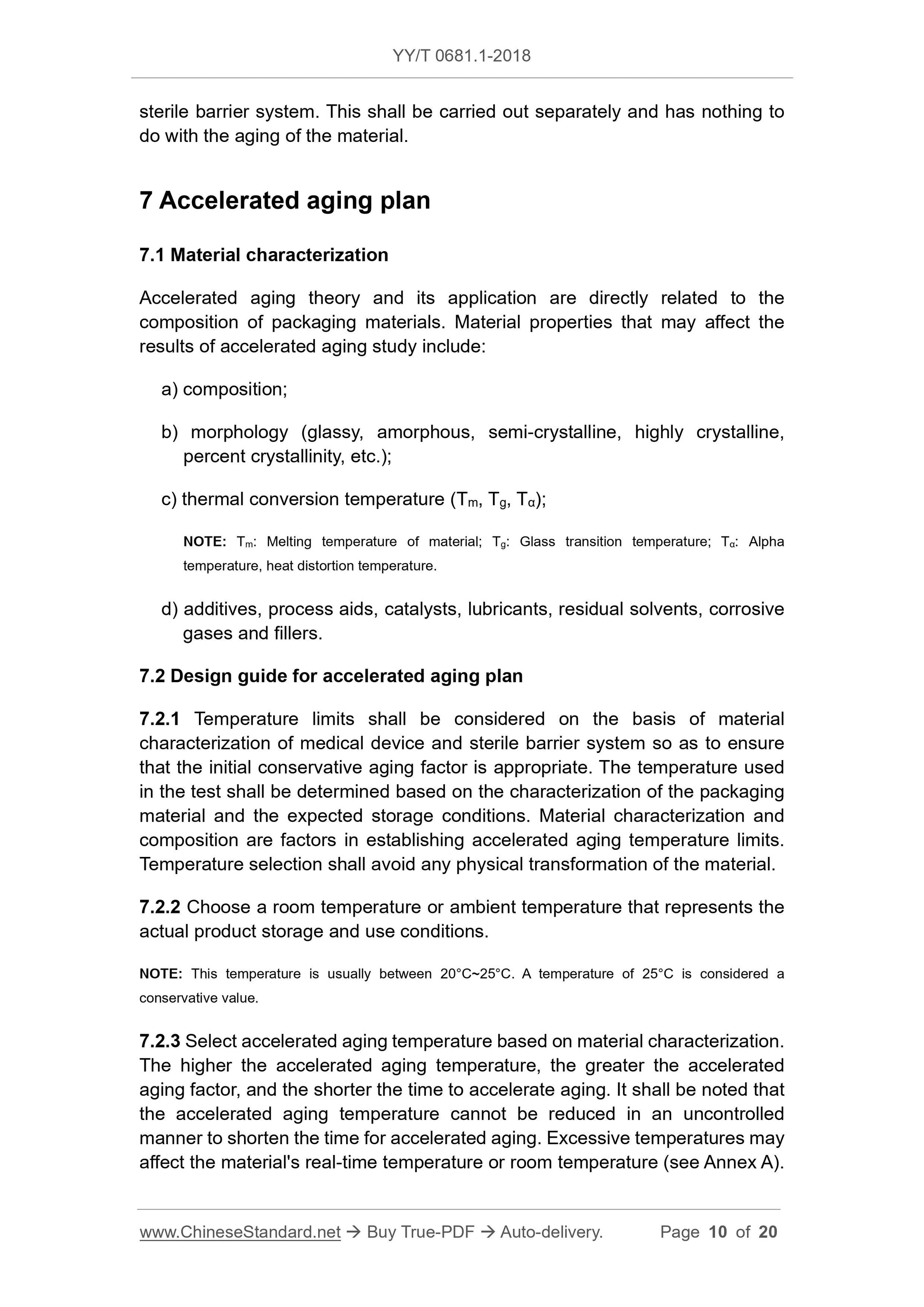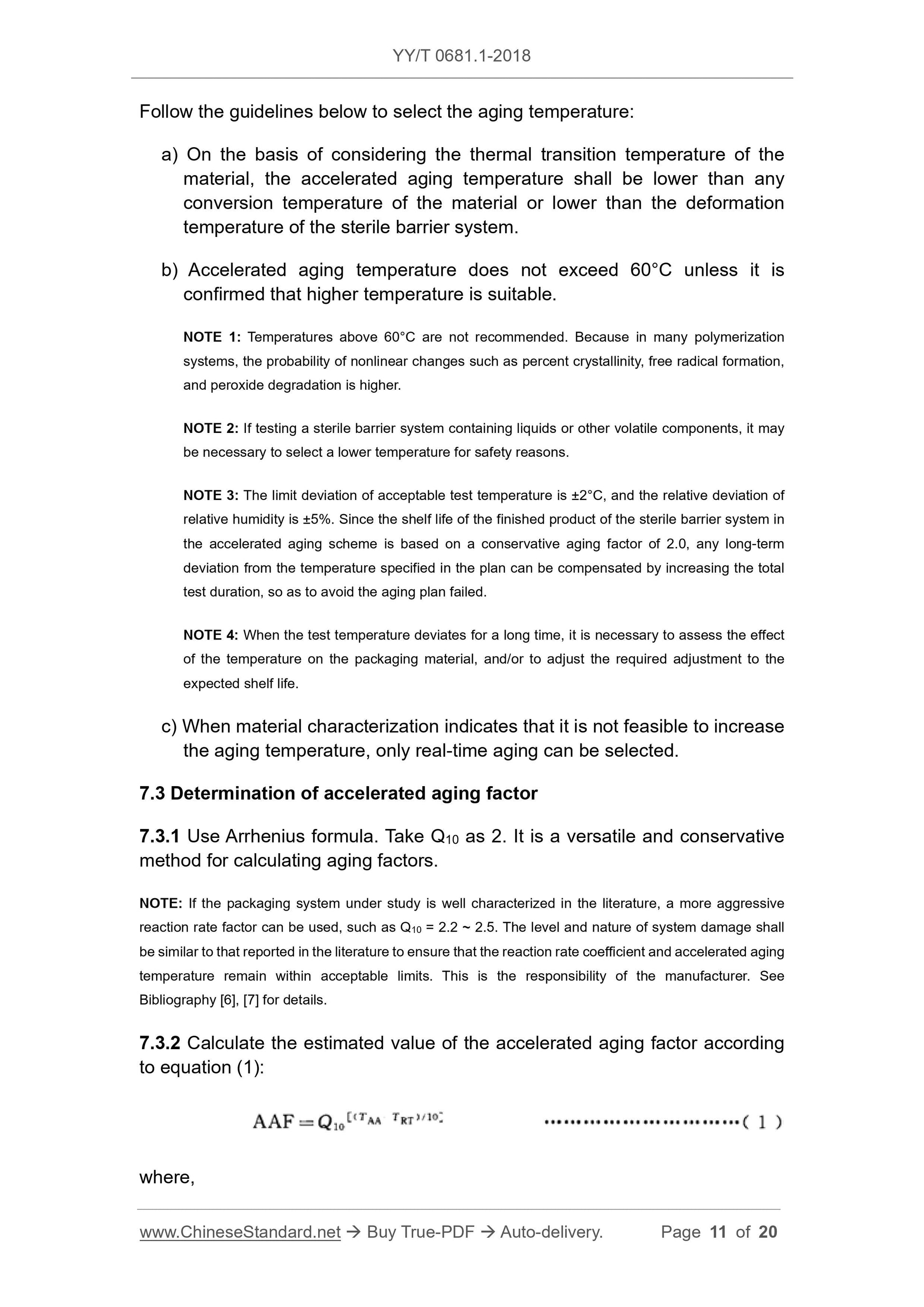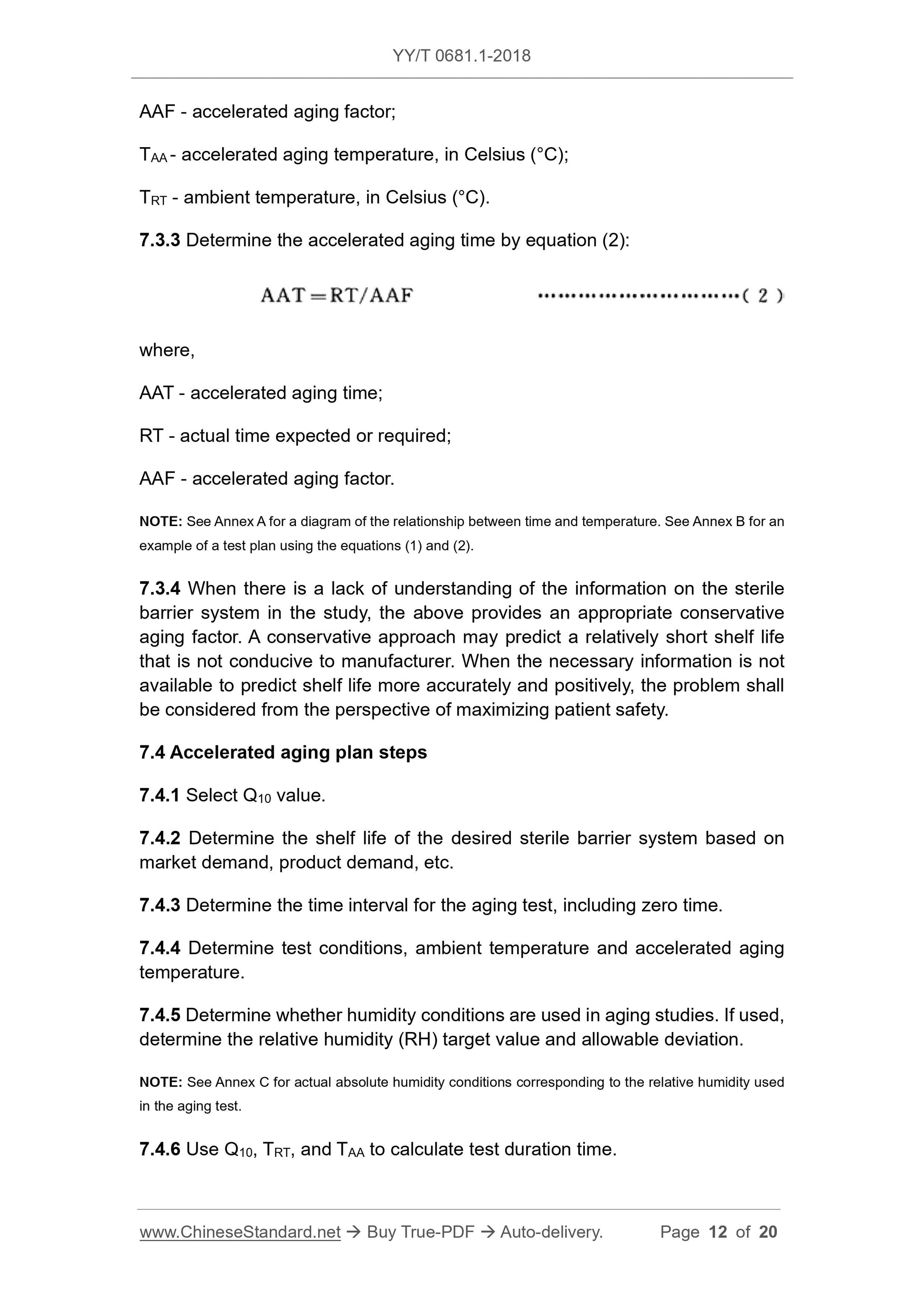1
/
of
12
www.ChineseStandard.us -- Field Test Asia Pte. Ltd.
YY/T 0681.1-2018 English PDF (YY/T0681.1-2018)
YY/T 0681.1-2018 English PDF (YY/T0681.1-2018)
Regular price
$205.00
Regular price
Sale price
$205.00
Unit price
/
per
Shipping calculated at checkout.
Couldn't load pickup availability
YY/T 0681.1-2018: Test methods for sterile medical device package - Part 1: Test guide for accelerated aging
Delivery: 9 seconds. Download (& Email) true-PDF + Invoice.
Get Quotation: Click YY/T 0681.1-2018 (Self-service in 1-minute)
Historical versions (Master-website): YY/T 0681.1-2018
Preview True-PDF (Reload/Scroll-down if blank)
YY/T 0681.1-2018
MEDICAL INDUSTRY STANDARD OF
THE PEOPLE’S REPUBLIC OF CHINA
ICS 11.080.040
C 31
Replacing YY/T 0681.1-2009
Test methods for sterile medical device package -
Part 1: Test guide for accelerated aging
ISSUED ON: DECEMBER 20, 2018
IMPLEMENTED ON: JANUARY 01, 2020
Issued by: National Medical Products Administration
Table of Contents
Foreword ... 3
1 Scope ... 6
2 Normative references ... 6
3 Terms and definitions ... 7
4 Meaning and application ... 8
5 Instruments ... 9
6 Accelerated aging theory ... 9
7 Accelerated aging plan ... 10
8 Post-aging test guide ... 13
9 Report ... 14
Annex A (normative) Accelerated aging of polymers ... 15
Annex B (informative) Example of shelf life test plan for sterile barrier system
... 16
Annex C (informative) Relative humidity used in aging solution ... 18
Bibliography ... 20
Foreword
YY/T 0681 “Test methods for sterile medical device package” consists of the
following 16 parts:
- Part 1: Test guide for accelerated aging;
- Part 2: Seal strength of flexible battier materials;
- Part 3: Internal pressurization failure resistance of unrestrained packages;
- Part 4: Detecting seal leaks in porous packages by dye penetration;
- Part 5: Detecting gross leaks in medical packaging by internal
pressurization (bubble test);
- Part 6: Evaluation of chemical resistance of printed inks and coatings on
flexible packaging materials;
- Part 7: Evaluating inks or coating adhesion to flexible packaging materials
using tape;
- Part 8: Coating/adhesive weight determination;
- Part 9: Burst testing of flexible package seals using internal air
pressurization weight restraining plates;
- Part 10: Test for microbial barrier ranking of porous package material;
- Part 11: Determining integrity of seals for medical packaging by visual
inspection;
- Part 12: Flex durability of flexible barrier films;
- Part 13: Slow rate penetration resistance of flexible barrier films and
laminates;
- Part 14: Breathable packaging materials for wet and dry microbial barrier
tests;
- Part 15: Performance test of transport containers and systems;
- Part 16: Packaging system climate strain capability test.
This is Part 1 of YY/T 0681.
This Part was drafted in accordance with the rules given in GB/T 1.1-2009.
Test methods for sterile medical device package -
Part 1: Test guide for accelerated aging
1 Scope
This Part of YY/T 0681 specifies the guide for designed accelerated aging
solutions.
This Part applies to the rapid determination of the sterile integrity of the sterile
barrier system specified in GB/T 19633.1-2015 and the effects that physical
properties of its packaging material components are affected by the elapsed
time.
NOTE 1: Use the information in this Part of YY/T 0681 to support the expiration date of the medical device
sterile barrier system (i.e. shelf life).
This Part is not applicable to real-time aging solution.
NOTE 2: Accelerated aging test involves sterile barrier system with or without instruments. This Part does
not address the compatibility of sterile barrier system materials with instrument interactions required during
new product development or evaluation.
NOTE 3: Real-time aging test is a basic aging study used to determine the results of accelerated aging
tests.
NOTE 4: This Part does not address methods for confirmation of sterile barrier system, including effects
on mechanical processing, sterilization processes, circulation, handling and transport. The ability of the
sterile barrier system to resist transport challenges is given in YY/T 0681.15.
NOTE 5: This Part does not address the effects of extreme weather conditions that may be experienced
in a simulated transport environment. For the climatic strain capacity test of the sterile barrier system, see
YY/T 0681.16.
2 Normative references
The following referenced documents are indispensable for the application of
this document. For dated references, only the edition cited applies. For undated
references, the latest edition of the referenced document (including any
amendments) applies.
GB/T 4857.2, Packaging - Transport packages - Temperature and humidity
conditioning
NOTE: The term “real-time aging” is also called “actual-time aging” in GB/T 19633.1-2015.
3.8 real-time equivalent
the length of time equivalent to real-time aging estimated for a given aging
condition
3.9 zero time
start time of aging study
4 Meaning and application
4.1 Degradation of physical properties of materials over time and degradation
of materials at bonding or heat sealing over time and dynamic events during
subsequent transport and handling, may lead to loss of integrity of the sterile
barrier system.
4.2 The packaging system shall provide protection and maintain the integrity of
the sterile barrier system. The sterile barrier system shall maintain its sterility
before or during the expiration date. Stability test shall confirm that the sterile
barrier system maintains its integrity at all times. Adopt stability test of
accelerated aging solution. Sufficient evidence of the nominal expiration date
shall be considered before the actual aging study data is issued.
4.3 Real-time aging procedures provide the best data to ensure that sterile
barrier system materials and sterile barrier system integrity do not degrade over
time. However, in the market conditions where product updates are fast, new
products need to be put into the market in the shortest possible time. But real-
time aging study cannot meet this purpose. Accelerated aging study provides
another alternative method. To ensure that accelerated aging study truly
represents real-time aging effects, real-time aging study shall be synchronized
with accelerated aging study. Real-time aging study shall be carried out to the
product's nominal shelf life and up to completion.
4.4 If there is a lack of understanding of the material of the sterile barrier system
being evaluated, a conservative accelerated aging factor shall be used. More
realistic accelerated aging factors can be used. But use documented evidence
to show the relationship between real-time aging and accelerated aging.
4.5 When accelerating the aging process to establish a nominal shelf life, it shall
be recognized that the data obtained from the study is based on a simulation of
the aging effect of the material. The established expiration date or shelf life is
based on the use of conservatively estimated aging factors (e.g. Q10). It is only
temporary before the real-time aging study of the sterile barrier system is
completed.
sterile barrier system. This shall be carried out separately and has nothing to
do with the aging of the material.
7 Accelerated aging plan
7.1 Material characterization
Accelerated aging theory and its application are directly related to the
composition of packaging materials. Material properties that may affect the
results of accelerated aging study include:
a) composition;
b) morphology (glassy, amorphous, semi-crystalline, highly crystalline,
percent crystallinity, etc.);
c) thermal conversion temperature (Tm, Tg, Tα);
NOTE: Tm: Melting temperature of material; Tg: Glass transition temperature; Tα: Alpha
temperature, heat distortion temperature.
d) additives, process aids, catalysts, lubricants, residual solvents, corrosive
gases and fillers.
7.2 Design guide for accelerated aging plan
7.2.1 Temperature limits shall be considered on the basis of material
characterization of medical device and sterile barrier system so as to ensure
that the initial conservative aging factor is appropriate. The temperature used
in the test shall be determined based on the characterization of the packaging
material and the expected storage conditions. Material characterization and
composition are factors in establishing accelerated aging temperature limits.
Temperature selection shall avoid any physical transformation of the material.
7.2.2 Choose a room temperature or ambient temperature that represents the
actual product storage and use conditions.
NOTE: This temperature is usually between 20°C~25°C. A temperature of 25°C is considered a
conservative value.
7.2.3 Select accelerated aging temperature based on material characterization.
The higher the accelerated aging temperature, the greater the accelerated
aging factor, and the shorter the time to accelerate aging. It shall be noted that
the accelerated aging temperature cannot be reduced in an uncontrolled
manner to shorten the time for accelerated aging. Excessive temperatures may
affect the material's real-time temperature or room temperature (see Annex A).
7.4.7 Define material properties, seal strength and seal integrity testing, sample
size and acceptance criteria for sterile barrier system.
7.4.8 Accelerate aging to sample under accelerated aging temperature. At the
same time, perform real-time aging of sample under real-time aging conditions
(ambient temperature).
7.4.9 Evaluate the performance of the sterile barrier system after accelerated
aging and the initial sterile barrier system requirements, such as packaging seal
strength, package integrity.
7.4.10 Evaluate whether the sterile barrier system meets its original design
requirements after real-time aging.
NOTE: The early accelerated aging factor method is a simple and conservative technique for evaluating
the long-term effects of aging on materials and seals. However, as with all accelerated aging techniques,
the estimated shelf life of the aging test is determined by real-time aging data.
8 Post-aging test guide
8.1 Evaluate physical properties and integrity of sterile barrier systems after
aging (e.g., accelerated aging and real-time aging).
8.2 The test selected for evaluation shall be able to challenge the most critical
function of the material or package or the function that is most likely to fail due
to aging.
8.3 It is advisable to evaluate the constituent materials and all seals or closures
of the equipment-free sterile barrier system that is subject to aging. Evaluate
various reductions in strength characteristics and ability to maintain integrity.
8.4 Aging test or stability test and performance test are two different tests.
Performance tests evaluate the interaction between packaging systems and
products caused by stresses imposed by the production, sterilization process,
and handling, storage, and transport environment. The aging of a particular
sterile barrier system is not affected by its physical structure or contents. As
long as the sterile barrier system is subjected to the same sterilization process,
regardless of its physical structure and contents, the material and seal are
expected to undergo the same aging.
8.5 If the packaging system has documented acceptable limits for performance
such as seal strength, puncture or impact resistance that meet the requirements
of the intended packaging system, then the specified physical test data shall be
complete.
8.6 Sometimes, packaging performance test can be performed on an aged
Annex B
(informative)
Example of shelf life test plan for sterile barrier system
B.1 Selection of Q10 value
Select conservative estimate of accelerated aging factor, such as Q10=2 (see
Figure A.1).
B.2 Determination of time interval
Determine the aging time point corresponding to the expected shelf life, such
as 2 years and 3 years.
NOTE: Trend analysis is often used to characterize the effects of aging on the properties of material and
sterile barrier system. At least one accelerated aging time point is set. But there must be a point in time
that corresponds to the expected shelf life (expected shelf life divided by the aging factor). However, when
using only one acceleration time point, there is such a risk. That is, it is unable to draw an early warning
from the previous accelerated aging time point, resulting in a test failure. Trend analysis shall consider at
least three time points.
B.3 Sample preparation
Prepare test samples according to the confirmed production process.
NOTE: Sterile barrier system for zero time, sterilization and accelerated aging, can be packaged with or
without analog products.
B.4 Sterilization
Sterilize the sterile barrier system with a validated sterilization process.
Sterilization process may affect the stability of materials or sterile barrier system.
Material and sterile barrier system shall be subjected to the most stringent
sterilization process conditions or cycles of prior use prior to aging studies.
B.5 State conditioning
Perform sample state conditioning according to GB/T 4857.2.
NOTE: When the device is in a protective package, the sterile barrier system performance test can be
performed as part of the aging protocol, so as to determine the long-term effects of transport, handling
and storage on sterile barrier system. Whether the performance test is performed before or after aging, it
shall depend on whether the study is transported first and then stored in the hospital shelf or simulated
before being stored in the manufacturer's shelf and then transported. But there may be situations where
YY/T 0681.1-2018
MEDICAL INDUSTRY STANDARD OF
THE PEOPLE’S REPUBLIC OF CHINA
ICS 11.080.040
C 31
Replacing YY/T 0681.1-2009
Test methods for sterile medical device package -
Part 1: Test guide for accelerated aging
ISSUED ON: DECEMBER 20, 2018
IMPLEMENTED ON: JANUARY 01, 2020
Issued by: National Medical Products Administration
Table of Contents
Foreword ... 3
1 Scope ... 6
2 Normative references ... 6
3 Terms and definitions ... 7
4 Meaning and application ... 8
5 Instruments ... 9
6 Accelerated aging theory ... 9
7 Accelerated aging plan ... 10
8 Post-aging test guide ... 13
9 Report ... 14
Annex A (normative) Accelerated aging of polymers ... 15
Annex B (informative) Example of shelf life test plan for sterile barrier system
... 16
Delivery: 9 seconds. Download (& Email) true-PDF + Invoice.
Get Quotation: Click YY/T 0681.1-2018 (Self-service in 1-minute)
Historical versions (Master-website): YY/T 0681.1-2018
Preview True-PDF (Reload/Scroll-down if blank)
YY/T 0681.1-2018
MEDICAL INDUSTRY STANDARD OF
THE PEOPLE’S REPUBLIC OF CHINA
ICS 11.080.040
C 31
Replacing YY/T 0681.1-2009
Test methods for sterile medical device package -
Part 1: Test guide for accelerated aging
ISSUED ON: DECEMBER 20, 2018
IMPLEMENTED ON: JANUARY 01, 2020
Issued by: National Medical Products Administration
Table of Contents
Foreword ... 3
1 Scope ... 6
2 Normative references ... 6
3 Terms and definitions ... 7
4 Meaning and application ... 8
5 Instruments ... 9
6 Accelerated aging theory ... 9
7 Accelerated aging plan ... 10
8 Post-aging test guide ... 13
9 Report ... 14
Annex A (normative) Accelerated aging of polymers ... 15
Annex B (informative) Example of shelf life test plan for sterile barrier system
... 16
Annex C (informative) Relative humidity used in aging solution ... 18
Bibliography ... 20
Foreword
YY/T 0681 “Test methods for sterile medical device package” consists of the
following 16 parts:
- Part 1: Test guide for accelerated aging;
- Part 2: Seal strength of flexible battier materials;
- Part 3: Internal pressurization failure resistance of unrestrained packages;
- Part 4: Detecting seal leaks in porous packages by dye penetration;
- Part 5: Detecting gross leaks in medical packaging by internal
pressurization (bubble test);
- Part 6: Evaluation of chemical resistance of printed inks and coatings on
flexible packaging materials;
- Part 7: Evaluating inks or coating adhesion to flexible packaging materials
using tape;
- Part 8: Coating/adhesive weight determination;
- Part 9: Burst testing of flexible package seals using internal air
pressurization weight restraining plates;
- Part 10: Test for microbial barrier ranking of porous package material;
- Part 11: Determining integrity of seals for medical packaging by visual
inspection;
- Part 12: Flex durability of flexible barrier films;
- Part 13: Slow rate penetration resistance of flexible barrier films and
laminates;
- Part 14: Breathable packaging materials for wet and dry microbial barrier
tests;
- Part 15: Performance test of transport containers and systems;
- Part 16: Packaging system climate strain capability test.
This is Part 1 of YY/T 0681.
This Part was drafted in accordance with the rules given in GB/T 1.1-2009.
Test methods for sterile medical device package -
Part 1: Test guide for accelerated aging
1 Scope
This Part of YY/T 0681 specifies the guide for designed accelerated aging
solutions.
This Part applies to the rapid determination of the sterile integrity of the sterile
barrier system specified in GB/T 19633.1-2015 and the effects that physical
properties of its packaging material components are affected by the elapsed
time.
NOTE 1: Use the information in this Part of YY/T 0681 to support the expiration date of the medical device
sterile barrier system (i.e. shelf life).
This Part is not applicable to real-time aging solution.
NOTE 2: Accelerated aging test involves sterile barrier system with or without instruments. This Part does
not address the compatibility of sterile barrier system materials with instrument interactions required during
new product development or evaluation.
NOTE 3: Real-time aging test is a basic aging study used to determine the results of accelerated aging
tests.
NOTE 4: This Part does not address methods for confirmation of sterile barrier system, including effects
on mechanical processing, sterilization processes, circulation, handling and transport. The ability of the
sterile barrier system to resist transport challenges is given in YY/T 0681.15.
NOTE 5: This Part does not address the effects of extreme weather conditions that may be experienced
in a simulated transport environment. For the climatic strain capacity test of the sterile barrier system, see
YY/T 0681.16.
2 Normative references
The following referenced documents are indispensable for the application of
this document. For dated references, only the edition cited applies. For undated
references, the latest edition of the referenced document (including any
amendments) applies.
GB/T 4857.2, Packaging - Transport packages - Temperature and humidity
conditioning
NOTE: The term “real-time aging” is also called “actual-time aging” in GB/T 19633.1-2015.
3.8 real-time equivalent
the length of time equivalent to real-time aging estimated for a given aging
condition
3.9 zero time
start time of aging study
4 Meaning and application
4.1 Degradation of physical properties of materials over time and degradation
of materials at bonding or heat sealing over time and dynamic events during
subsequent transport and handling, may lead to loss of integrity of the sterile
barrier system.
4.2 The packaging system shall provide protection and maintain the integrity of
the sterile barrier system. The sterile barrier system shall maintain its sterility
before or during the expiration date. Stability test shall confirm that the sterile
barrier system maintains its integrity at all times. Adopt stability test of
accelerated aging solution. Sufficient evidence of the nominal expiration date
shall be considered before the actual aging study data is issued.
4.3 Real-time aging procedures provide the best data to ensure that sterile
barrier system materials and sterile barrier system integrity do not degrade over
time. However, in the market conditions where product updates are fast, new
products need to be put into the market in the shortest possible time. But real-
time aging study cannot meet this purpose. Accelerated aging study provides
another alternative method. To ensure that accelerated aging study truly
represents real-time aging effects, real-time aging study shall be synchronized
with accelerated aging study. Real-time aging study shall be carried out to the
product's nominal shelf life and up to completion.
4.4 If there is a lack of understanding of the material of the sterile barrier system
being evaluated, a conservative accelerated aging factor shall be used. More
realistic accelerated aging factors can be used. But use documented evidence
to show the relationship between real-time aging and accelerated aging.
4.5 When accelerating the aging process to establish a nominal shelf life, it shall
be recognized that the data obtained from the study is based on a simulation of
the aging effect of the material. The established expiration date or shelf life is
based on the use of conservatively estimated aging factors (e.g. Q10). It is only
temporary before the real-time aging study of the sterile barrier system is
completed.
sterile barrier system. This shall be carried out separately and has nothing to
do with the aging of the material.
7 Accelerated aging plan
7.1 Material characterization
Accelerated aging theory and its application are directly related to the
composition of packaging materials. Material properties that may affect the
results of accelerated aging study include:
a) composition;
b) morphology (glassy, amorphous, semi-crystalline, highly crystalline,
percent crystallinity, etc.);
c) thermal conversion temperature (Tm, Tg, Tα);
NOTE: Tm: Melting temperature of material; Tg: Glass transition temperature; Tα: Alpha
temperature, heat distortion temperature.
d) additives, process aids, catalysts, lubricants, residual solvents, corrosive
gases and fillers.
7.2 Design guide for accelerated aging plan
7.2.1 Temperature limits shall be considered on the basis of material
characterization of medical device and sterile barrier system so as to ensure
that the initial conservative aging factor is appropriate. The temperature used
in the test shall be determined based on the characterization of the packaging
material and the expected storage conditions. Material characterization and
composition are factors in establishing accelerated aging temperature limits.
Temperature selection shall avoid any physical transformation of the material.
7.2.2 Choose a room temperature or ambient temperature that represents the
actual product storage and use conditions.
NOTE: This temperature is usually between 20°C~25°C. A temperature of 25°C is considered a
conservative value.
7.2.3 Select accelerated aging temperature based on material characterization.
The higher the accelerated aging temperature, the greater the accelerated
aging factor, and the shorter the time to accelerate aging. It shall be noted that
the accelerated aging temperature cannot be reduced in an uncontrolled
manner to shorten the time for accelerated aging. Excessive temperatures may
affect the material's real-time temperature or room temperature (see Annex A).
7.4.7 Define material properties, seal strength and seal integrity testing, sample
size and acceptance criteria for sterile barrier system.
7.4.8 Accelerate aging to sample under accelerated aging temperature. At the
same time, perform real-time aging of sample under real-time aging conditions
(ambient temperature).
7.4.9 Evaluate the performance of the sterile barrier system after accelerated
aging and the initial sterile barrier system requirements, such as packaging seal
strength, package integrity.
7.4.10 Evaluate whether the sterile barrier system meets its original design
requirements after real-time aging.
NOTE: The early accelerated aging factor method is a simple and conservative technique for evaluating
the long-term effects of aging on materials and seals. However, as with all accelerated aging techniques,
the estimated shelf life of the aging test is determined by real-time aging data.
8 Post-aging test guide
8.1 Evaluate physical properties and integrity of sterile barrier systems after
aging (e.g., accelerated aging and real-time aging).
8.2 The test selected for evaluation shall be able to challenge the most critical
function of the material or package or the function that is most likely to fail due
to aging.
8.3 It is advisable to evaluate the constituent materials and all seals or closures
of the equipment-free sterile barrier system that is subject to aging. Evaluate
various reductions in strength characteristics and ability to maintain integrity.
8.4 Aging test or stability test and performance test are two different tests.
Performance tests evaluate the interaction between packaging systems and
products caused by stresses imposed by the production, sterilization process,
and handling, storage, and transport environment. The aging of a particular
sterile barrier system is not affected by its physical structure or contents. As
long as the sterile barrier system is subjected to the same sterilization process,
regardless of its physical structure and contents, the material and seal are
expected to undergo the same aging.
8.5 If the packaging system has documented acceptable limits for performance
such as seal strength, puncture or impact resistance that meet the requirements
of the intended packaging system, then the specified physical test data shall be
complete.
8.6 Sometimes, packaging performance test can be performed on an aged
Annex B
(informative)
Example of shelf life test plan for sterile barrier system
B.1 Selection of Q10 value
Select conservative estimate of accelerated aging factor, such as Q10=2 (see
Figure A.1).
B.2 Determination of time interval
Determine the aging time point corresponding to the expected shelf life, such
as 2 years and 3 years.
NOTE: Trend analysis is often used to characterize the effects of aging on the properties of material and
sterile barrier system. At least one accelerated aging time point is set. But there must be a point in time
that corresponds to the expected shelf life (expected shelf life divided by the aging factor). However, when
using only one acceleration time point, there is such a risk. That is, it is unable to draw an early warning
from the previous accelerated aging time point, resulting in a test failure. Trend analysis shall consider at
least three time points.
B.3 Sample preparation
Prepare test samples according to the confirmed production process.
NOTE: Sterile barrier system for zero time, sterilization and accelerated aging, can be packaged with or
without analog products.
B.4 Sterilization
Sterilize the sterile barrier system with a validated sterilization process.
Sterilization process may affect the stability of materials or sterile barrier system.
Material and sterile barrier system shall be subjected to the most stringent
sterilization process conditions or cycles of prior use prior to aging studies.
B.5 State conditioning
Perform sample state conditioning according to GB/T 4857.2.
NOTE: When the device is in a protective package, the sterile barrier system performance test can be
performed as part of the aging protocol, so as to determine the long-term effects of transport, handling
and storage on sterile barrier system. Whether the performance test is performed before or after aging, it
shall depend on whether the study is transported first and then stored in the hospital shelf or simulated
before being stored in the manufacturer's shelf and then transported. But there may be situations where
YY/T 0681.1-2018
MEDICAL INDUSTRY STANDARD OF
THE PEOPLE’S REPUBLIC OF CHINA
ICS 11.080.040
C 31
Replacing YY/T 0681.1-2009
Test methods for sterile medical device package -
Part 1: Test guide for accelerated aging
ISSUED ON: DECEMBER 20, 2018
IMPLEMENTED ON: JANUARY 01, 2020
Issued by: National Medical Products Administration
Table of Contents
Foreword ... 3
1 Scope ... 6
2 Normative references ... 6
3 Terms and definitions ... 7
4 Meaning and application ... 8
5 Instruments ... 9
6 Accelerated aging theory ... 9
7 Accelerated aging plan ... 10
8 Post-aging test guide ... 13
9 Report ... 14
Annex A (normative) Accelerated aging of polymers ... 15
Annex B (informative) Example of shelf life test plan for sterile barrier system
... 16
Share
